2
RESEARCH METHODOLOGY
47
5
MARKET OVERVIEW
Epigenetics market thrives on declining sequencing costs, multi-omics integration, and therapeutic demand growth.
68
5.2.1.1
Declining sequencing costs and time
5.2.1.2
Growing emphasis on population-scale screening initiatives
5.2.1.3
Technological advancements in epigenetics research
5.2.1.4
Rising demand for epigenetic drugs and epigenetic-based therapeutics
5.2.2.1
Limited applications of epigenomic data in toxicology
5.2.2.2
Data privacy concerns and security issues
5.2.3.1
Emerging applications of epigenetics
5.2.3.2
Integration of multi-omics
5.2.4.1
Concerns regarding quality of antibodies
5.2.4.2
Challenges associated with epigenetic editing
5.3
TRENDS/DISRUPTIONS IMPACTING CUSTOMER BUSINESS
5.4.1
AVERAGE SELLING PRICE TREND, BY KEY PLAYER
5.4.2
AVERAGE SELLING PRICE TREND, BY REGION
5.7
INVESTMENT AND FUNDING SCENARIO
5.8.1.1
Single-cell sequencing
5.8.1.2
Chromatin immunoprecipitation
5.8.2
COMPLEMENTARY TECHNOLOGIES
5.8.2.1
DNA methylation microarrays
5.8.2.2
CRISPR-based genome editing
5.11
KEY CONFERENCES AND EVENTS, 2025–2026
5.12
TARIFF AND REGULATORY LANDSCAPE
5.12.1
TARIFF DATA FOR HS CODES 9027.50.80 AND 3822.00
5.12.2
REGULATORY FRAMEWORK
5.12.3
REGULATORY BODIES, GOVERNMENT AGENCIES, AND OTHER ORGANIZATIONS
5.13
PORTER’S FIVE FORCES ANALYSIS
5.13.1
BARGAINING POWER OF SUPPLIERS
5.13.2
BARGAINING POWER OF BUYERS
5.13.3
THREAT OF NEW ENTRANTS
5.13.4
THREAT OF SUBSTITUTES
5.13.5
INTENSITY OF COMPETITIVE RIVALRY
5.14
KEY STAKEHOLDERS AND BUYING CRITERIA
5.14.1
KEY STAKEHOLDERS IN BUYING PROCESS
5.14.2
KEY BUYING CRITERIA
5.15
IMPACT OF AI/GEN AI ON EPIGENETICS MARKET
5.15.2
MARKET POTENTIAL OF AI IN EPIGENETICS
5.15.4
KEY COMPANIES IMPLEMENTING AI/GEN AI
5.15.5
FUTURE OF AI/GEN AI IN EPIGENETICS MARKET
5.16
IMPACT OF 2025 US TARIFF
5.16.3
PRICE IMPACT ANALYSIS
5.16.4
KEY IMPACTS ON VARIOUS REGIONS
5.16.5
END-USE INDUSTRY IMPACT
5.16.5.1
Pharmaceutical and biotech companies
5.16.5.2
Contract Research Organizations (CROs)
5.16.5.3
Academic and research institutes
6
EPIGENETICS MARKET, BY OFFERING
Market Size & Growth Rate Forecast Analysis to 2030 in USD Million | 108 Data Tables
116
6.2.1.1
Growing demand for recombinant antibodies for detection of epigenetic targets to propel market
6.2.2
CHIP-SEQUENCING KITS & REAGENTS
6.2.2.1
Versatile applications of chromatin immunoprecipitation pertaining to epigenetic regulatory systems to boost market
6.2.3
BISULFITE CONVERSION KITS & REAGENTS
6.2.3.1
Effective outcomes associated with bisulfite conversion to sustain growth
6.2.4
WHOLE-GENOME AMPLIFICATION KITS & REAGENTS
6.2.4.1
Ability to maintain relative proportions of genes in original pool to stimulate growth
6.2.5
5-HMC & 5-MC ANALYSIS KITS & REAGENTS
6.2.5.1
Introduction of unique kits for 5-mC and 5-hmC analysis to support growth
6.2.6.1
Emerging importance of chromatin-associated proteins and histones in epigenetic research to bolster growth
6.2.7
OTHER KITS & REAGENTS
6.3.1
DNA-MODIFYING ENZYMES
6.3.1.1
Broadening applications of DNA methylation to facilitate growth
6.3.2
PROTEIN-MODIFYING ENZYMES
6.3.2.1
Increasing pipeline of epigenetics-based drugs targeting histone-modifying enzymes to spur growth
6.4
INSTRUMENTS & ACCESSORIES
6.4.1
WIDE USAGE OF NGS INSTRUMENTS AND SONICATORS TO EXPEDITE GROWTH
6.5.1
DEVELOPMENT OF VIABLE SOFTWARE SOLUTIONS FOR DNA METHYLATION AND RNA ANALYSIS TO PROMOTE GROWTH
6.6.1
EXPANDING POOL OF SERVICE PROVIDERS TO DRIVE MARKET
7
EPIGENETICS MARKET, BY TECHNOLOGY
Market Size & Growth Rate Forecast Analysis to 2030 in USD Million | 36 Data Tables
171
7.2
NEXT-GENERATION SEQUENCING (NGS)
7.2.1
INCREASING LAUNCHES OF NEXT-GENERATION SEQUENCING PLATFORMS TO FACILITATE GROWTH
7.3.1
RISING NUMBER OF PCR-BASED EPIGENETICS SERVICE PROVIDERS TO DRIVE MARKET
7.4.1
GROWING DEMAND FOR MASS SPECTROMETRY IN COMPREHENSIVE STUDIES ON HISTONE EPIGENETICS TO BOOST MARKET
7.5.1
RISING USE OF SONICATION IN SCIENTIFIC AND INDUSTRIAL SETTINGS TO EXPEDITE GROWTH
8
EPIGENETICS MARKET, BY METHOD
Market Size & Growth Rate Forecast Analysis to 2030 in USD Million | 23 Data Tables
192
8.2.1
INCREASING RESEARCH & DEVELOPMENT ACTIVITIES TO SPUR GROWTH
8.3
HISTONE MODIFICATIONS
8.3.1
GROWING TECHNOLOGICAL ADVANCEMENTS TO DRIVE MARKET
9
EPIGENETICS MARKET, BY APPLICATION
Market Size & Growth Rate Forecast Analysis to 2030 in USD Million | 44 Data Tables
204
9.2.1
GROWING INVESTMENT IN EPIGENETIC-BASED RESEARCH TO BOOST MARKET
9.3.1
EMERGING ROLE OF DNA METHYLATION IN DIABETES MANAGEMENT TO FAVOR GROWTH
9.4.1
GROWING DEMAND FOR EPIGENETIC PRODUCTS IN TUMOR AND TRANSPLANTATION IMMUNOLOGY TO DRIVE MARKET
9.5
DEVELOPMENTAL BIOLOGY
9.5.1
INCREASING RESEARCH ON CELL GROWTH AND DIFFERENTIATION TO PROPEL MARKET
9.6
CARDIOVASCULAR DISEASES
9.6.1
EMERGING ROLE OF EPIGENETICS IN UNDERSTANDING ETIOLOGY OF CARDIOVASCULAR DISEASES TO AID GROWTH
10
EPIGENETICS PRODUCTS MARKET, BY END USER
Market Size & Growth Rate Forecast Analysis to 2030 in USD Million | 29 Data Tables
229
10.2
ACADEMIC & RESEARCH INSTITUTES
10.2.1
INCREASING PUBLIC-PRIVATE COLLABORATIONS TO FAVOR GROWTH
10.3
PHARMACEUTICAL & BIOTECHNOLOGY COMPANIES
10.3.1
GROWING NUMBER OF CLINICAL TRIALS FOR EPIGENETIC-BASED DRUGS TO FUEL MARKET
10.4.1
GROWING USE OF PERSONALIZED MEDICINE TO PROPEL MARKET
10.5
CONTRACT RESEARCH ORGANIZATIONS
10.5.1
INCREASING DEMAND FOR SCALABLE, HIGH-THROUGHPUT EPIGENETICS KITS TO PROMOTE GROWTH
11
EPIGENETICS SERVICE MARKET, BY END USER
Market Size & Growth Rate Forecast Analysis to 2030 in USD Million | 22 Data Tables
246
11.2
PHARMACEUTICAL & BIOTECHNOLOGY COMPANIES
11.2.1
RISING DEMAND FOR THERAPEUTIC DISCOVERIES TO BOLSTER GROWTH
11.3
ACADEMIC & RESEARCH INSTITUTES
11.3.1
INCREASING VOLUME OF HIGH-THROUGHPUT EPIGENOMIC DATA TO AUGMENT GROWTH
11.4.1
INCREASING INTEGRATION OF EPIGENETIC ASSAYS INTO CLINICAL DIAGNOSTICS, PROGNOSTICS, AND PERSONALIZED MEDICINE TO AID GROWTH
12
EPIGENETICS MARKET, BY REGION
Market Size & Growth Rate Forecast Analysis to 2030 in USD Million | 265 Data Tables
258
12.2.1
MACROECONOMIC OUTLOOK FOR NORTH AMERICA
12.2.2.1
Strong network of well-established epigenetic product manufacturers to spur growth
12.2.3.1
Favorable government initiatives to contribute to growth
12.3.1
MACROECONOMIC OUTLOOK FOR EUROPE
12.3.2.1
Significant investments in next-generation sequencing to bolster growth
12.3.3.1
Rising acceptance of genome-based diagnostic techniques to support growth
12.3.4.1
Growing demand for PCR technologies to drive market
12.3.5.1
High incidence of cancer to expedite growth
12.3.6.1
Well-established network of research centers and universities to boost market
12.4.1
MACROECONOMIC OUTLOOK FOR ASIA PACIFIC
12.4.2.1
High demand for personalized medicine to accelerate growth
12.4.3.1
Increasing collaborations between research & academic organizations to favor growth
12.4.4.1
Expanding base of biotechnology facilities to drive market
12.4.5.1
Growing hub for epigenetics to propel market
12.4.6.1
Rising burden of chronic diseases to foster growth
12.4.7
REST OF ASIA PACIFIC
12.5.1
MACROECONOMIC OUTLOOK FOR LATIN AMERICA
12.5.2.1
Increasing number of healthcare providers incorporating epigenetic testing to aid growth
12.5.3.1
Growing adoption of cutting-edge technologies to drive market
12.5.4
REST OF LATIN AMERICA
12.6.1
MACROECONOMIC OUTLOOK FOR MIDDLE EAST
12.6.2.3
Rest of GCC countries
12.6.3
REST OF MIDDLE EAST
12.7.1
RISING DEMAND FOR TARGETED THERAPIES TO AUGMENT GROWTH
12.7.2
MACROECONOMIC OUTLOOK FOR AFRICA
13
COMPETITIVE LANDSCAPE
Uncover strategic insights and market positions of leading and emerging players in the competitive landscape.
393
13.2
KEY PLAYER STRATEGIES
13.4
MARKET SHARE ANALYSIS
13.5
COMPANY VALUATION AND FINANCIAL METRICS
13.6
BRAND/PRODUCT COMPARISON
13.6.1
THERMO FISHER SCIENTIFIC INC.
13.7
COMPANY EVALUATION MATRIX: KEY PLAYERS, 2024
13.7.5
COMPANY FOOTPRINT: KEY PLAYERS, 2024
13.7.5.1
Company footprint
13.7.5.2
Region footprint
13.7.5.3
Offering footprint
13.7.5.4
Method footprint
13.7.5.5
Technology footprint
13.8
COMPANY EVALUATION MATRIX: STARTUPS/SMES, 2024
13.8.1
PROGRESSIVE COMPANIES
13.8.2
RESPONSIVE COMPANIES
13.8.5
COMPETITIVE BENCHMARKING
13.8.5.1
Detailed list of key startups/SMEs
13.8.5.2
Competitive benchmarking of key startups/SMEs
13.9
COMPETITIVE SCENARIO
14
COMPANY PROFILES
In-depth Company Profiles of Leading Market Players with detailed Business Overview, Product and Service Portfolio, Recent Developments, and Unique Analyst Perspective (MnM View)
413
14.1.1
THERMO FISHER SCIENTIFIC INC.
14.1.1.1
Business overview
14.1.1.2
Products offered
14.1.1.3
Recent developments
14.1.6
BIO-RAD LABORATORIES, INC.
14.1.8
NEW ENGLAND BIOLABS
14.1.10
ZYMO RESEARCH CORPORATION
14.1.13
F. HOFFMANN-LA ROCHE LTD
14.1.14
PROMEGA CORPORATION
14.1.15
EPIGENTEK GROUP INC.
14.2.5
BPS BIOSCIENCE, INC.
14.2.6
ABNOVA CORPORATION
14.2.7
CREATIVE DIAGNOSTICS
14.2.9
INTEGRATED DNA TECHNOLOGIES, INC.
14.2.10
NOVOGENE CO., LTD.
15.2
KNOWLEDGESTORE: MARKETSANDMARKETS’ SUBSCRIPTION PORTAL
15.3
CUSTOMIZATION OPTIONS
TABLE 1
EPIGENETICS MARKET: INCLUSIONS AND EXCLUSIONS
TABLE 2
IMPACT ANALYSIS OF SUPPLY- AND DEMAND-SIDE FACTORS
TABLE 3
EPIGENETICS MARKET: RISK ANALYSIS
TABLE 4
EPIGENETICS MARKET: IMPACT ANALYSIS OF MARKET DYNAMICS
TABLE 5
AVERAGE SELLING PRICE TREND OF EPIGENETIC PRODUCTS, BY KEY PLAYER, 2022–2024 (USD MILLION)
TABLE 6
AVERAGE SELLING PRICE TREND OF EPIGENETIC INSTRUMENTS, BY REGION, 2022–2024 (USD MILLION)
TABLE 7
AVERAGE SELLING PRICE TREND OF EPIGENETIC KITS AND REAGENTS, BY REGION, 2022–2024 (USD MILLION)
TABLE 8
AVERAGE SELLING PRICE TREND OF EPIGENETIC ENZYMES, BY REGION, 2022–2024 (USD MILLION)
TABLE 9
EPIGENETICS MARKET: ROLE OF COMPANIES IN ECOSYSTEM
TABLE 10
EPIGENETICS MARKET: INVESTMENT AND FUNDING SCENARIO OF KEY PLAYERS, 2022−2025
TABLE 11
EPIGENETICS MARKET: PATENTS FILED GLOBALLY, 2014−2024
TABLE 12
EPIGENETICS MARKET: LIST OF PATENTS/PATENT APPLICATIONS, 2024–2025
TABLE 13
IMPORT VALUE OF HS CODE 9027.50– COMPLIANT PRODUCTS FOR TOP 20 COUNTRIES, 2020–2024 (USD THOUSAND)
TABLE 14
IMPORT VALUE OF HS CODE 382.00– COMPLIANT PRODUCTS FOR TOP 20 COUNTRIES, 2020–2024 (USD THOUSAND)
TABLE 15
EXPORT VALUE OF HS CODE 9027.50 – COMPLIANT PRODUCTS FOR TOP 20 COUNTRIES, 2020–2024 (USD THOUSAND)
TABLE 16
EXPORT VALUE OF HS CODE 3822.00 – COMPLIANT PRODUCTS FOR TOP 20 COUNTRIES, 2020–2024 (USD THOUSAND)
TABLE 17
EPIGENETICS MARKET: KEY CONFERENCES AND EVENTS, 2025–2026
TABLE 18
TARIFF DATA FOR HS CODES 9027.50.80 AND 3822.00
TABLE 19
KEY REGULATORY AGENCIES
TABLE 20
NORTH AMERICA: REGULATORY BODIES, GOVERNMENT AGENCIES, AND OTHER ORGANIZATIONS
TABLE 21
EUROPE: REGULATORY BODIES, GOVERNMENT AGENCIES, AND OTHER ORGANIZATIONS
TABLE 22
ASIA PACIFIC: REGULATORY BODIES, GOVERNMENT AGENCIES, AND OTHER ORGANIZATIONS
TABLE 23
LATIN AMERICA: REGULATORY BODIES, GOVERNMENT AGENCIES, AND OTHER ORGANIZATIONS
TABLE 24
MIDDLE EAST: REGULATORY BODIES, GOVERNMENT AGENCIES, AND OTHER ORGANIZATIONS
TABLE 25
AFRICA: REGULATORY BODIES, GOVERNMENT AGENCIES, AND OTHER ORGANIZATIONS
TABLE 26
EPIGENETICS MARKET: PORTER’S FIVE FORCES ANALYSIS
TABLE 27
INFLUENCE OF KEY STAKEHOLDERS ON BUYING PROCESS, BY OFFERING
TABLE 28
KEY BUYING CRITERIA, BY END USER
TABLE 29
LIST OF COMPANIES IMPLEMENTING AI/GEN AI IN EPIGENETICS MARKET
TABLE 30
US ADJUSTED RECIPROCAL TARIFF RATES
TABLE 31
EXPORTS AND IMPORTS, BY REGION, 2024–2025
TABLE 32
KEY PRODUCT-RELATED TARIFF: HS CODES FOR PRODUCTS RELEVANT TO EPIGENETICS
TABLE 33
CRITICAL COMPONENTS LIKELY EXPOSED TO TARIFF CHANGES
TABLE 34
EPIGENETICS MARKET, BY OFFERING, 2023–2030 (USD MILLION)
TABLE 35
EPIGENETICS MARKET FOR KITS & REAGENTS, BY TYPE, 2023–2030 (USD MILLION)
TABLE 36
EPIGENETICS MARKET FOR KITS & REAGENTS, BY REGION, 2023–2030 (USD MILLION)
TABLE 37
NORTH AMERICA: EPIGENETICS MARKET FOR KITS & REAGENTS, BY COUNTRY, 2023–2030 (USD MILLION)
TABLE 38
EUROPE: EPIGENETICS MARKET FOR KITS & REAGENTS, BY COUNTRY, 2023–2030 (USD MILLION)
TABLE 39
ASIA PACIFIC: EPIGENETICS MARKET FOR KITS & REAGENTS, BY COUNTRY, 2023–2030 (USD MILLION)
TABLE 40
LATIN AMERICA: EPIGENETICS MARKET FOR KITS & REAGENTS, BY COUNTRY, 2023–2030 (USD MILLION)
TABLE 41
MIDDLE EAST: EPIGENETICS MARKET FOR KITS & REAGENTS, BY REGION, 2023–2030 (USD MILLION)
TABLE 42
GCC COUNTRIES: EPIGENETICS MARKET FOR KITS & REAGENTS, BY COUNTRY, 2023–2030 (USD MILLION)
TABLE 43
EPIGENETICS MARKET FOR ANTIBODIES, BY REGION, 2023–2030 (USD MILLION)
TABLE 44
NORTH AMERICA: EPIGENETICS MARKET FOR ANTIBODIES, BY COUNTRY, 2023–2030 (USD MILLION)
TABLE 45
EUROPE: EPIGENETICS MARKET FOR ANTIBODIES, BY COUNTRY, 2023–2030 (USD MILLION)
TABLE 46
ASIA PACIFIC: EPIGENETICS MARKET FOR ANTIBODIES, BY COUNTRY, 2023–2030 (USD MILLION)
TABLE 47
LATIN AMERICA: EPIGENETICS MARKET FOR ANTIBODIES, BY COUNTRY, 2023–2030 (USD MILLION)
TABLE 48
MIDDLE EAST: EPIGENETICS MARKET FOR ANTIBODIES, BY REGION, 2023–2030 (USD MILLION)
TABLE 49
GCC COUNTRIES: EPIGENETICS MARKET FOR ANTIBODIES, BY COUNTRY, 2023–2030 (USD MILLION)
TABLE 50
EPIGENETICS MARKET FOR CHIP-SEQUENCING KITS & REAGENTS, BY REGION, 2023–2030 (USD MILLION)
TABLE 51
NORTH AMERICA: EPIGENETICS MARKET FOR CHIP-SEQUENCING KITS & REAGENTS, BY COUNTRY, 2023–2030 (USD MILLION)
TABLE 52
EUROPE: EPIGENETICS MARKET FOR CHIP-SEQUENCING KITS & REAGENTS, BY COUNTRY, 2023–2030 (USD MILLION)
TABLE 53
ASIA PACIFIC: EPIGENETICS MARKET FOR CHIP-SEQUENCING KITS & REAGENTS, BY COUNTRY, 2023–2030 (USD MILLION)
TABLE 54
LATIN AMERICA: EPIGENETICS MARKET FOR CHIP-SEQUENCING KITS & REAGENTS, BY COUNTRY, 2023–2030 (USD MILLION)
TABLE 55
MIDDLE EAST: EPIGENETICS MARKET FOR CHIP-SEQUENCING KITS & REAGENTS, BY REGION, 2023–2030 (USD MILLION)
TABLE 56
GCC COUNTRIES: EPIGENETICS MARKET FOR CHIP-SEQUENCING KITS & REAGENTS, BY COUNTRY, 2023–2030 (USD MILLION)
TABLE 57
EPIGENETICS MARKET FOR BISULFITE CONVERSION KITS & REAGENTS, BY REGION, 2023–2030 (USD MILLION)
TABLE 58
NORTH AMERICA: EPIGENETICS MARKET FOR BISULFITE CONVERSION KITS & REAGENTS, BY COUNTRY, 2023–2030 (USD MILLION)
TABLE 59
EUROPE: EPIGENETICS MARKET FOR BISULFITE CONVERSION KITS & REAGENTS, BY COUNTRY, 2023–2030 (USD MILLION)
TABLE 60
ASIA PACIFIC: EPIGENETICS MARKET FOR BISULFITE CONVERSION KITS & REAGENTS, BY COUNTRY, 2023–2030 (USD MILLION)
TABLE 61
LATIN AMERICA: EPIGENETICS MARKET FOR BISULFITE CONVERSION KITS & REAGENTS, BY COUNTRY, 2023–2030 (USD MILLION)
TABLE 62
MIDDLE EAST: EPIGENETICS MARKET FOR BISULFITE CONVERSION KITS & REAGENTS, BY REGION, 2023–2030 (USD MILLION)
TABLE 63
GCC COUNTRIES: EPIGENETICS MARKET FOR BISULFITE CONVERSION KITS & REAGENTS, BY COUNTRY, 2023–2030 (USD MILLION)
TABLE 64
EPIGENETICS MARKET FOR WHOLE-GENOME AMPLIFICATION KITS & REAGENTS, BY REGION, 2023–2030 (USD MILLION)
TABLE 65
NORTH AMERICA: EPIGENETICS MARKET FOR WHOLE-GENOME AMPLIFICATION KITS & REAGENTS, BY COUNTRY, 2023–2030 (USD MILLION)
TABLE 66
EUROPE: EPIGENETICS MARKET FOR WHOLE-GENOME AMPLIFICATION KITS & REAGENTS, BY COUNTRY, 2023–2030 (USD MILLION)
TABLE 67
ASIA PACIFIC: EPIGENETICS MARKET FOR WHOLE-GENOME AMPLIFICATION KITS & REAGENTS, BY COUNTRY, 2023–2030 (USD MILLION)
TABLE 68
LATIN AMERICA: EPIGENETICS MARKET FOR WHOLE-GENOME AMPLIFICATION KITS & REAGENTS, BY COUNTRY, 2023–2030 (USD MILLION)
TABLE 69
MIDDLE EAST: EPIGENETICS MARKET FOR WHOLE-GENOME AMPLIFICATION KITS & REAGENTS, BY REGION, 2023–2030 (USD MILLION)
TABLE 70
GCC COUNTRIES: EPIGENETICS MARKET FOR WHOLE-GENOME AMPLIFICATION KITS & REAGENTS, BY COUNTRY, 2023–2030 (USD MILLION)
TABLE 71
EPIGENETICS MARKET FOR 5-HMC & 5-MC ANALYSIS KITS & REAGENTS, BY REGION, 2023–2030 (USD MILLION)
TABLE 72
NORTH AMERICA: EPIGENETICS MARKET FOR 5-HMC & 5-MC ANALYSIS KITS & REAGENTS, BY COUNTRY, 2023–2030 (USD MILLION)
TABLE 73
EUROPE: EPIGENETICS MARKET FOR 5-HMC & 5-MC ANALYSIS KITS & REAGENTS, BY COUNTRY, 2023–2030 (USD MILLION)
TABLE 74
ASIA PACIFIC: EPIGENETICS MARKET FOR 5-HMC & 5-MC ANALYSIS KITS & REAGENTS, BY COUNTRY, 2023–2030 (USD MILLION)
TABLE 75
LATIN AMERICA: EPIGENETICS MARKET FOR 5-HMC & 5-MC ANALYSIS KITS & REAGENTS, BY COUNTRY, 2023–2030 (USD MILLION)
TABLE 76
MIDDLE EAST: EPIGENETICS MARKET FOR 5-HMC & 5-MC ANALYSIS KITS & REAGENTS, BY REGION, 2023–2030 (USD MILLION)
TABLE 77
GCC COUNTRIES: EPIGENETICS MARKET FOR 5-HMC & 5-MC ANALYSIS KITS & REAGENTS, BY COUNTRY, 2023–2030 (USD MILLION)
TABLE 78
EPIGENETICS MARKET FOR HISTONES, BY REGION, 2023–2030 (USD MILLION)
TABLE 79
NORTH AMERICA: EPIGENETICS MARKET FOR HISTONES, BY COUNTRY, 2023–2030 (USD MILLION)
TABLE 80
EUROPE: EPIGENETICS MARKET FOR HISTONES, BY COUNTRY, 2023–2030 (USD MILLION)
TABLE 81
ASIA PACIFIC: EPIGENETICS MARKET FOR HISTONES, BY COUNTRY, 2023–2030 (USD MILLION)
TABLE 82
LATIN AMERICA: EPIGENETICS MARKET FOR HISTONES, BY COUNTRY, 2023–2030 (USD MILLION)
TABLE 83
MIDDLE EAST: EPIGENETICS MARKET FOR HISTONES, BY REGION, 2023–2030 (USD MILLION)
TABLE 84
GCC COUNTRIES: EPIGENETICS MARKET FOR HISTONES, BY COUNTRY, 2023–2030 (USD MILLION)
TABLE 85
EPIGENETICS MARKET FOR OTHER KITS & REAGENTS, BY REGION, 2023–2030 (USD MILLION)
TABLE 86
NORTH AMERICA: EPIGENETICS MARKET FOR OTHER KITS & REAGENTS, BY COUNTRY, 2023–2030 (USD MILLION)
TABLE 87
EUROPE: EPIGENETICS MARKET FOR OTHER KITS & REAGENTS, BY COUNTRY, 2023–2030 (USD MILLION)
TABLE 88
ASIA PACIFIC: EPIGENETICS MARKET FOR OTHER KITS & REAGENTS, BY COUNTRY, 2023–2030 (USD MILLION)
TABLE 89
LATIN AMERICA: EPIGENETICS MARKET FOR OTHER KITS & REAGENTS, BY COUNTRY, 2023–2030 (USD MILLION)
TABLE 90
MIDDLE EAST: EPIGENETICS MARKET FOR OTHER KITS & REAGENTS, BY REGION, 2023–2030 (USD MILLION)
TABLE 91
GCC COUNTRIES: EPIGENETICS MARKET FOR OTHER KITS & REAGENTS, BY COUNTRY, 2023–2030 (USD MILLION)
TABLE 92
EPIGENETICS MARKET FOR ENZYMES, BY TYPE, 2023–2030 (USD MILLION)
TABLE 93
EPIGENETICS MARKET FOR ENZYMES, BY REGION, 2023–2030 (USD MILLION)
TABLE 94
NORTH AMERICA: EPIGENETICS MARKET FOR ENZYMES, BY COUNTRY, 2023–2030 (USD MILLION)
TABLE 95
EUROPE: EPIGENETICS MARKET FOR ENZYMES, BY COUNTRY, 2023–2030 (USD MILLION)
TABLE 96
ASIA PACIFIC: EPIGENETICS MARKET FOR ENZYMES, BY COUNTRY, 2023–2030 (USD MILLION)
TABLE 97
LATIN AMERICA: EPIGENETICS MARKET FOR ENZYMES, BY COUNTRY, 2023–2030 (USD MILLION)
TABLE 98
MIDDLE EAST: EPIGENETICS MARKET FOR ENZYMES, BY REGION, 2023–2030 (USD MILLION)
TABLE 99
GCC COUNTRIES: EPIGENETICS MARKET FOR ENZYMES, BY COUNTRY, 2023–2030 (USD MILLION)
TABLE 100
EPIGENETICS MARKET FOR DNA-MODIFYING ENZYMES, BY REGION, 2023–2030 (USD MILLION)
TABLE 101
NORTH AMERICA: EPIGENETICS MARKET FOR DNA-MODIFYING ENZYMES, BY COUNTRY, 2023–2030 (USD MILLION)
TABLE 102
EUROPE: EPIGENETICS MARKET FOR DNA-MODIFYING ENZYMES, BY COUNTRY, 2023–2030 (USD MILLION)
TABLE 103
ASIA PACIFIC: EPIGENETICS MARKET FOR DNA-MODIFYING ENZYMES, BY COUNTRY, 2023–2030 (USD MILLION)
TABLE 104
LATIN AMERICA: EPIGENETICS MARKET FOR DNA-MODIFYING ENZYMES, BY COUNTRY, 2023–2030 (USD MILLION)
TABLE 105
MIDDLE EAST: EPIGENETICS MARKET FOR DNA-MODIFYING ENZYMES, BY REGION, 2023–2030 (USD MILLION)
TABLE 106
GCC COUNTRIES: EPIGENETICS MARKET FOR DNA-MODIFYING ENZYMES, BY COUNTRY, 2023–2030 (USD MILLION)
TABLE 107
EPIGENETICS MARKET FOR PROTEIN-MODIFYING ENZYMES, BY REGION, 2023–2030 (USD MILLION)
TABLE 108
NORTH AMERICA: EPIGENETICS MARKET FOR PROTEIN-MODIFYING ENZYMES, BY COUNTRY, 2023–2030 (USD MILLION)
TABLE 109
EUROPE: EPIGENETICS MARKET FOR PROTEIN-MODIFYING ENZYMES, BY COUNTRY, 2023–2030 (USD MILLION)
TABLE 110
ASIA PACIFIC: EPIGENETICS MARKET FOR PROTEIN-MODIFYING ENZYMES, BY COUNTRY, 2023–2030 (USD MILLION)
TABLE 111
LATIN AMERICA: EPIGENETICS MARKET FOR PROTEIN-MODIFYING ENZYMES, BY COUNTRY, 2023–2030 (USD MILLION)
TABLE 112
MIDDLE EAST: EPIGENETICS MARKET FOR PROTEIN-MODIFYING ENZYMES, BY REGION, 2023–2030 (USD MILLION)
TABLE 113
GCC COUNTRIES: EPIGENETICS MARKET FOR PROTEIN-MODIFYING ENZYMES, BY COUNTRY, 2023–2030 (USD MILLION)
TABLE 114
EPIGENETICS MARKET FOR OTHER ENZYMES, BY REGION, 2023–2030 (USD MILLION)
TABLE 115
NORTH AMERICA: EPIGENETICS MARKET FOR OTHER ENZYMES, BY COUNTRY, 2023–2030 (USD MILLION)
TABLE 116
EUROPE: EPIGENETICS MARKET FOR OTHER ENZYMES, BY COUNTRY, 2023–2030 (USD MILLION)
TABLE 117
ASIA PACIFIC: EPIGENETICS MARKET FOR OTHER ENZYMES, BY COUNTRY, 2023–2030 (USD MILLION)
TABLE 118
LATIN AMERICA: EPIGENETICS MARKET FOR OTHER ENZYMES, BY COUNTRY, 2023–2030 (USD MILLION)
TABLE 119
MIDDLE EAST: EPIGENETICS MARKET FOR OTHER ENZYMES, BY REGION, 2023–2030 (USD MILLION)
TABLE 120
GCC COUNTRIES: EPIGENETICS MARKET FOR OTHER ENZYMES, BY COUNTRY, 2023–2030 (USD MILLION)
TABLE 121
EPIGENETICS MARKET FOR INSTRUMENTS & ACCESSORIES, BY REGION, 2023–2030 (USD MILLION)
TABLE 122
NORTH AMERICA: EPIGENETICS MARKET FOR INSTRUMENTS & ACCESSORIES, BY COUNTRY, 2023–2030 (USD MILLION)
TABLE 123
EUROPE: EPIGENETICS MARKET FOR INSTRUMENTS & ACCESSORIES, BY COUNTRY, 2023–2030 (USD MILLION)
TABLE 124
ASIA PACIFIC: EPIGENETICS MARKET FOR INSTRUMENTS & ACCESSORIES, BY COUNTRY, 2023–2030 (USD MILLION)
TABLE 125
LATIN AMERICA: EPIGENETICS MARKET FOR INSTRUMENTS & ACCESSORIES, BY COUNTRY, 2023–2030 (USD MILLION)
TABLE 126
MIDDLE EAST: EPIGENETICS MARKET FOR INSTRUMENTS & ACCESSORIES, BY REGION, 2023–2030 (USD MILLION)
TABLE 127
GCC COUNTRIES: EPIGENETICS MARKET FOR INSTRUMENTS & ACCESSORIES, BY COUNTRY, 2023–2030 (USD MILLION)
TABLE 128
EPIGENETICS MARKET FOR SOFTWARE, BY REGION, 2023–2030 (USD MILLION)
TABLE 129
NORTH AMERICA: EPIGENETICS MARKET FOR SOFTWARE, BY COUNTRY, 2023–2030 (USD MILLION)
TABLE 130
EUROPE: EPIGENETICS MARKET FOR SOFTWARE, BY COUNTRY, 2023–2030 (USD MILLION)
TABLE 131
ASIA PACIFIC: EPIGENETICS MARKET FOR SOFTWARE, BY COUNTRY, 2023–2030 (USD MILLION)
TABLE 132
LATIN AMERICA: EPIGENETICS MARKET FOR SOFTWARE, BY COUNTRY, 2023–2030 (USD MILLION)
TABLE 133
MIDDLE EAST: EPIGENETICS MARKET FOR SOFTWARE, BY REGION, 2023–2030 (USD MILLION)
TABLE 134
REST OF GCC COUNTRIES: EPIGENETICS MARKET FOR SOFTWARE, BY COUNTRY, 2023–2030 (USD MILLION)
TABLE 135
EPIGENETICS MARKET FOR SERVICES, BY REGION, 2023–2030 (USD MILLION)
TABLE 136
NORTH AMERICA: EPIGENETICS MARKET FOR SERVICES, BY COUNTRY, 2023–2030 (USD MILLION)
TABLE 137
EUROPE: EPIGENETICS MARKET FOR SERVICES, BY COUNTRY, 2023–2030 (USD MILLION)
TABLE 138
ASIA PACIFIC: EPIGENETICS MARKET FOR SERVICES, BY COUNTRY, 2023–2030 (USD MILLION)
TABLE 139
LATIN AMERICA: EPIGENETICS MARKET FOR SERVICES, BY COUNTRY, 2023–2030 (USD MILLION)
TABLE 140
MIDDLE EAST: EPIGENETICS MARKET FOR SERVICES, BY REGION, 2023–2030 (USD MILLION)
TABLE 141
GCC COUNTRIES: EPIGENETICS MARKET FOR SERVICES, BY COUNTRY, 2023–2030 (USD MILLION)
TABLE 142
EPIGENETICS MARKET, BY TECHNOLOGY, 2023–2030 (USD MILLION)
TABLE 143
EPIGENETICS MARKET FOR NEXT-GENERATION SEQUENCING, BY REGION, 2023–2030 (USD MILLION)
TABLE 144
NORTH AMERICA: EPIGENETICS MARKET FOR NEXT-GENERATION SEQUENCING, BY COUNTRY, 2023–2030 (USD MILLION)
TABLE 145
EUROPE: EPIGENETICS MARKET FOR NEXT-GENERATION SEQUENCING, BY COUNTRY, 2023–2030 (USD MILLION)
TABLE 146
ASIA PACIFIC: EPIGENETICS MARKET FOR NEXT-GENERATION SEQUENCING, BY COUNTRY, 2023–2030 (USD MILLION)
TABLE 147
LATIN AMERICA: EPIGENETICS MARKET FOR NEXT-GENERATION SEQUENCING, BY COUNTRY, 2023–2030 (USD MILLION)
TABLE 148
MIDDLE EAST: EPIGENETICS MARKET FOR NEXT-GENERATION SEQUENCING, BY REGION, 2023–2030 (USD MILLION)
TABLE 149
GCC COUNTRIES: EPIGENETICS MARKET FOR NEXT-GENERATION SEQUENCING, BY COUNTRY, 2023–2030 (USD MILLION)
TABLE 150
EPIGENETICS MARKET FOR PCR & QPCR, BY REGION, 2023–2030 (USD MILLION)
TABLE 151
NORTH AMERICA: EPIGENETICS MARKET FOR PCR & QPCR, BY COUNTRY, 2023–2030 (USD MILLION)
TABLE 152
EUROPE: EPIGENETICS MARKET FOR PCR & QPCR, BY COUNTRY, 2023–2030 (USD MILLION)
TABLE 153
ASIA PACIFIC: EPIGENETICS MARKET FOR PCR & QPCR, BY COUNTRY, 2023–2030 (USD MILLION)
TABLE 154
LATIN AMERICA: EPIGENETICS MARKET FOR PCR & QPCR, BY COUNTRY, 2023–2030 (USD MILLION)
TABLE 155
MIDDLE EAST: EPIGENETICS MARKET FOR PCR & QPCR, BY REGION, 2023–2030 (USD MILLION)
TABLE 156
GCC COUNTRIES: EPIGENETICS MARKET FOR PCR & QPCR, BY COUNTRY, 2023–2030 (USD MILLION)
TABLE 157
EPIGENETICS MARKET FOR MASS SPECTROMETRY, BY REGION, 2023–2030 (USD MILLION)
TABLE 158
NORTH AMERICA: EPIGENETICS MARKET FOR MASS SPECTROMETRY, BY COUNTRY, 2023–2030 (USD MILLION)
TABLE 159
EUROPE: EPIGENETICS MARKET FOR MASS SPECTROMETRY, BY COUNTRY, 2023–2030 (USD MILLION)
TABLE 160
ASIA PACIFIC: EPIGENETICS MARKET FOR MASS SPECTROMETRY, BY COUNTRY, 2023–2030 (USD MILLION)
TABLE 161
LATIN AMERICA: EPIGENETICS MARKET FOR MASS SPECTROMETRY, BY COUNTRY, 2023–2030 (USD MILLION)
TABLE 162
MIDDLE EAST: EPIGENETICS MARKET FOR MASS SPECTROMETRY, BY REGION, 2023–2030 (USD MILLION)
TABLE 163
GCC COUNTRIES: EPIGENETICS MARKET FOR MASS SPECTROMETRY, BY COUNTRY, 2023–2030 (USD MILLION)
TABLE 164
EPIGENETICS MARKET FOR SONICATION, BY REGION, 2023–2030 (USD MILLION)
TABLE 165
NORTH AMERICA: EPIGENETICS MARKET FOR SONICATION, BY COUNTRY, 2023–2030 (USD MILLION)
TABLE 166
EUROPE: EPIGENETICS MARKET FOR SONICATION, BY COUNTRY, 2023–2030 (USD MILLION)
TABLE 167
ASIA PACIFIC: EPIGENETICS MARKET FOR SONICATION, BY COUNTRY, 2023–2030 (USD MILLION)
TABLE 168
LATIN AMERICA: EPIGENETICS MARKET FOR SONICATION, BY COUNTRY, 2023–2030 (USD MILLION)
TABLE 169
MIDDLE EAST: EPIGENETICS MARKET FOR SONICATION, BY REGION, 2023–2030 (USD MILLION)
TABLE 170
GCC COUNTRIES: EPIGENETICS MARKET FOR SONICATION, BY COUNTRY, 2023–2030 (USD MILLION)
TABLE 171
EPIGENETICS MARKET FOR OTHER TECHNOLOGIES, BY REGION, 2023–2030 (USD MILLION)
TABLE 172
NORTH AMERICA: EPIGENETICS MARKET FOR OTHER TECHNOLOGIES, BY COUNTRY, 2023–2030 (USD MILLION)
TABLE 173
EUROPE: EPIGENETICS MARKET FOR OTHER TECHNOLOGIES, BY COUNTRY, 2023–2030 (USD MILLION)
TABLE 174
ASIA PACIFIC: EPIGENETICS MARKET FOR OTHER TECHNOLOGIES, BY COUNTRY, 2023–2030 (USD MILLION)
TABLE 175
LATIN AMERICA: EPIGENETICS MARKET FOR OTHER TECHNOLOGIES, BY COUNTRY, 2023–2030 (USD MILLION)
TABLE 176
MIDDLE EAST: EPIGENETICS MARKET FOR OTHER TECHNOLOGIES, BY REGION, 2023–2030 (USD MILLION)
TABLE 177
GCC COUNTRIES: EPIGENETICS MARKET FOR OTHER TECHNOLOGIES, BY COUNTRY, 2023–2030 (USD MILLION)
TABLE 178
EPIGENETICS MARKET, BY METHOD, 2023–2030 (USD MILLION)
TABLE 179
EPIGENETICS MARKET FOR DNA METHYLATION, BY REGION, 2023–2030 (USD MILLION)
TABLE 180
NORTH AMERICA: EPIGENETICS MARKET FOR DNA METHYLATION, BY COUNTRY, 2023–2030 (USD MILLION)
TABLE 181
EUROPE: EPIGENETICS MARKET FOR DNA METHYLATION, BY COUNTRY, 2023–2030 (USD MILLION)
TABLE 182
ASIA PACIFIC: EPIGENETICS MARKET FOR DNA METHYLATION, BY COUNTRY, 2023–2030 (USD MILLION)
TABLE 183
LATIN AMERICA: EPIGENETICS MARKET FOR DNA METHYLATION, BY COUNTRY, 2023–2030 (USD MILLION)
TABLE 184
MIDDLE EAST: EPIGENETICS MARKET FOR DNA METHYLATION, BY REGION, 2023–2030 (USD MILLION)
TABLE 185
GCC COUNTRIES: EPIGENETICS MARKET FOR DNA METHYLATION, BY COUNTRY, 2023–2030 (USD MILLION)
TABLE 186
COMMON HISTONE MODIFICATIONS AND RESPECTIVE LOCATIONS
TABLE 187
EPIGENETICS MARKET FOR HISTONE MODIFICATIONS, BY REGION, 2023–2030 (USD MILLION)
TABLE 188
NORTH AMERICA: EPIGENETICS MARKET FOR HISTONE MODIFICATIONS, BY COUNTRY, 2023–2030 (USD MILLION)
TABLE 189
EUROPE: EPIGENETICS MARKET FOR HISTONE MODIFICATIONS, BY COUNTRY, 2023–2030 (USD MILLION)
TABLE 190
ASIA PACIFIC: EPIGENETICS MARKET FOR HISTONE MODIFICATIONS, BY COUNTRY, 2023–2030 (USD MILLION)
TABLE 191
LATIN AMERICA: EPIGENETICS MARKET FOR HISTONE MODIFICATIONS, BY COUNTRY, 2023–2030 (USD MILLION)
TABLE 192
MIDDLE EAST: EPIGENETICS MARKET FOR HISTONE MODIFICATIONS, BY REGION, 2023–2030 (USD MILLION)
TABLE 193
GCC COUNTRIES: EPIGENETICS MARKET FOR HISTONE MODIFICATIONS, BY COUNTRY, 2023–2030 (USD MILLION)
TABLE 194
EPIGENETICS MARKET FOR OTHER METHODS, BY REGION, 2023–2030 (USD MILLION)
TABLE 195
NORTH AMERICA: EPIGENETICS MARKET FOR OTHER METHODS, BY COUNTRY, 2023–2030 (USD MILLION)
TABLE 196
EUROPE: EPIGENETICS MARKET FOR OTHER METHODS, BY COUNTRY, 2023–2030 (USD MILLION)
TABLE 197
ASIA PACIFIC: EPIGENETICS MARKET FOR OTHER METHODS, BY COUNTRY, 2023–2030 (USD MILLION)
TABLE 198
LATIN AMERICA: EPIGENETICS MARKET FOR OTHER METHODS, BY COUNTRY, 2023–2030 (USD MILLION)
TABLE 199
MIDDLE EAST: EPIGENETICS MARKET FOR OTHER METHODS, BY REGION, 2023–2030 (USD MILLION)
TABLE 200
GCC COUNTRIES: EPIGENETICS MARKET FOR OTHER METHODS, BY COUNTRY, 2023–2030 (USD MILLION)
TABLE 201
EPIGENETICS MARKET, BY APPLICATION, 2023–2030 (USD MILLION)
TABLE 202
EPIGENOME-TARGETING CANCER DRUGS APPROVED OR IN CLINICAL TRIALS
TABLE 203
EPIGENETICS MARKET FOR ONCOLOGY, BY REGION, 2023–2030 (USD MILLION)
TABLE 204
NORTH AMERICA: EPIGENETICS MARKET FOR ONCOLOGY, BY COUNTRY, 2023–2030 (USD MILLION)
TABLE 205
EUROPE: EPIGENETICS MARKET FOR ONCOLOGY, BY COUNTRY, 2023–2030 (USD MILLION)
TABLE 206
ASIA PACIFIC: EPIGENETICS MARKET FOR ONCOLOGY, BY COUNTRY, 2023–2030 (USD MILLION)
TABLE 207
LATIN AMERICA: EPIGENETICS MARKET FOR ONCOLOGY, BY COUNTRY, 2023–2030 (USD MILLION)
TABLE 208
MIDDLE EAST: EPIGENETICS MARKET FOR ONCOLOGY, BY REGION, 2023–2030 (USD MILLION)
TABLE 209
GCC COUNTRIES: EPIGENETICS MARKET FOR ONCOLOGY, BY COUNTRY, 2023–2030 (USD MILLION)
TABLE 210
EPIGENETICS MARKET FOR METABOLIC DISEASES, BY REGION, 2023–2030 (USD MILLION)
TABLE 211
NORTH AMERICA: EPIGENETICS MARKET FOR METABOLIC DISEASES, BY COUNTRY, 2023–2030 (USD MILLION)
TABLE 212
EUROPE: EPIGENETICS MARKET FOR METABOLIC DISEASES, BY COUNTRY, 2023–2030 (USD MILLION)
TABLE 213
ASIA PACIFIC: EPIGENETICS MARKET FOR METABOLIC DISEASES, BY COUNTRY, 2023–2030 (USD MILLION)
TABLE 214
LATIN AMERICA: EPIGENETICS MARKET FOR METABOLIC DISEASES, BY COUNTRY, 2023–2030 (USD MILLION)
TABLE 215
MIDDLE EAST: EPIGENETICS MARKET FOR METABOLIC DISEASES, BY REGION, 2023–2030 (USD MILLION)
TABLE 216
GCC COUNTRIES: EPIGENETICS MARKET FOR METABOLIC DISEASES, BY COUNTRY, 2023–2030 (USD MILLION)
TABLE 217
EPIGENETICS MARKET FOR IMMUNOLOGY, BY REGION, 2023–2030 (USD MILLION)
TABLE 218
NORTH AMERICA: EPIGENETICS MARKET FOR IMMUNOLOGY, BY COUNTRY, 2023–2030 (USD MILLION)
TABLE 219
EUROPE: EPIGENETICS MARKET FOR IMMUNOLOGY, BY COUNTRY, 2023–2030 (USD MILLION)
TABLE 220
ASIA PACIFIC: EPIGENETICS MARKET FOR IMMUNOLOGY, BY COUNTRY, 2023–2030 (USD MILLION)
TABLE 221
LATIN AMERICA: EPIGENETICS MARKET FOR IMMUNOLOGY, BY COUNTRY, 2023–2030 (USD MILLION)
TABLE 222
MIDDLE EAST: EPIGENETICS MARKET FOR IMMUNOLOGY, BY REGION, 2023–2030 (USD MILLION)
TABLE 223
GCC COUNTRIES: EPIGENETICS MARKET FOR IMMUNOLOGY, BY COUNTRY, 2023–2030 (USD MILLION)
TABLE 224
EPIGENETICS MARKET FOR DEVELOPMENTAL BIOLOGY, BY REGION, 2023–2030 (USD MILLION)
TABLE 225
NORTH AMERICA: EPIGENETICS MARKET FOR DEVELOPMENTAL BIOLOGY, BY COUNTRY, 2023–2030 (USD MILLION)
TABLE 226
EUROPE: EPIGENETICS MARKET FOR DEVELOPMENTAL BIOLOGY, BY COUNTRY, 2023–2030 (USD MILLION)
TABLE 227
ASIA PACIFIC: EPIGENETICS MARKET FOR DEVELOPMENTAL BIOLOGY, BY COUNTRY, 2023–2030 (USD MILLION)
TABLE 228
LATIN AMERICA: EPIGENETICS MARKET FOR DEVELOPMENTAL BIOLOGY, BY COUNTRY, 2023–2030 (USD MILLION)
TABLE 229
MIDDLE EAST: EPIGENETICS MARKET FOR DEVELOPMENTAL BIOLOGY, BY REGION, 2023–2030 (USD MILLION)
TABLE 230
GCC COUNTRIES: EPIGENETICS MARKET FOR DEVELOPMENTAL BIOLOGY, BY COUNTRY, 2023–2030 (USD MILLION)
TABLE 231
EPIGENETICS MARKET FOR CARDIOVASCULAR DISEASES, BY REGION, 2023–2030 (USD MILLION)
TABLE 232
NORTH AMERICA: EPIGENETICS MARKET FOR CARDIOVASCULAR DISEASES, BY COUNTRY, 2023–2030 (USD MILLION)
TABLE 233
EUROPE: EPIGENETICS MARKET FOR CARDIOVASCULAR DISEASES, BY COUNTRY, 2023–2030 (USD MILLION)
TABLE 234
ASIA PACIFIC: EPIGENETICS MARKET FOR CARDIOVASCULAR DISEASES, BY COUNTRY, 2023–2030 (USD MILLION)
TABLE 235
LATIN AMERICA: EPIGENETICS MARKET FOR CARDIOVASCULAR DISEASES, BY COUNTRY, 2023–2030 (USD MILLION)
TABLE 236
MIDDLE EAST: EPIGENETICS MARKET FOR CARDIOVASCULAR DISEASES, BY REGION, 2023–2030 (USD MILLION)
TABLE 237
GCC COUNTRIES: EPIGENETICS MARKET FOR CARDIOVASCULAR DISEASES, BY COUNTRY, 2023–2030 (USD MILLION)
TABLE 238
EPIGENETICS MARKET FOR OTHER APPLICATIONS, BY REGION, 2023–2030 (USD MILLION)
TABLE 239
NORTH AMERICA: EPIGENETICS MARKET FOR OTHER APPLICATIONS, BY COUNTRY, 2023–2030 (USD MILLION)
TABLE 240
EUROPE: EPIGENETICS MARKET FOR OTHER APPLICATIONS, BY COUNTRY, 2023–2030 (USD MILLION)
TABLE 241
ASIA PACIFIC: EPIGENETICS MARKET FOR OTHER APPLICATIONS, BY COUNTRY, 2023–2030 (USD MILLION)
TABLE 242
LATIN AMERICA: EPIGENETICS MARKET FOR OTHER APPLICATIONS, BY COUNTRY, 2023–2030 (USD MILLION)
TABLE 243
MIDDLE EAST: EPIGENETICS MARKET FOR OTHER APPLICATIONS, BY REGION, 2023–2030 (USD MILLION)
TABLE 244
GCC COUNTRIES: EPIGENETICS MARKET FOR OTHER APPLICATIONS, BY COUNTRY, 2023–2030 (USD MILLION)
TABLE 245
EPIGENETICS PRODUCT MARKET, BY END USER, 2023–2030 (USD MILLION)
TABLE 246
EPIGENETICS PRODUCT MARKET FOR ACADEMIC & RESEARCH INSTITUTES, BY REGION, 2023–2030 (USD MILLION)
TABLE 247
NORTH AMERICA: EPIGENETICS PRODUCT MARKET FOR ACADEMIC & RESEARCH INSTITUTES, BY COUNTRY, 2023–2030 (USD MILLION)
TABLE 248
EUROPE: EPIGENETICS PRODUCT MARKET FOR ACADEMIC & RESEARCH INSTITUTES, BY COUNTRY, 2023–2030 (USD MILLION)
TABLE 249
ASIA PACIFIC: EPIGENETICS PRODUCT MARKET FOR ACADEMIC & RESEARCH INSTITUTES, BY COUNTRY, 2023–2030 (USD MILLION)
TABLE 250
LATIN AMERICA: EPIGENETICS PRODUCT MARKET FOR ACADEMIC & RESEARCH INSTITUTES, BY COUNTRY, 2023–2030 (USD MILLION)
TABLE 251
MIDDLE EAST: EPIGENETICS PRODUCT MARKET FOR ACADEMIC & RESEARCH INSTITUTES, BY REGION, 2023–2030 (USD MILLION)
TABLE 252
GCC COUNTRIES: EPIGENETICS PRODUCT MARKET FOR ACADEMIC & RESEARCH INSTITUTES, BY COUNTRY, 2023–2030 (USD MILLION)
TABLE 253
EPIGENETICS PRODUCT MARKET FOR PHARMACEUTICAL & BIOTECHNOLOGY COMPANIES, BY REGION, 2023–2030 (USD MILLION)
TABLE 254
NORTH AMERICA: EPIGENETICS PRODUCT MARKET FOR PHARMACEUTICAL & BIOTECHNOLOGY COMPANIES, BY COUNTRY, 2023–2030 (USD MILLION)
TABLE 255
EUROPE: EPIGENETICS PRODUCT MARKET FOR PHARMACEUTICAL & BIOTECHNOLOGY COMPANIES, BY COUNTRY, 2023–2030 (USD MILLION)
TABLE 256
ASIA PACIFIC: EPIGENETICS PRODUCT MARKET FOR PHARMACEUTICAL & BIOTECHNOLOGY COMPANIES, BY COUNTRY, 2023–2030 (USD MILLION)
TABLE 257
LATIN AMERICA: EPIGENETICS PRODUCT MARKET FOR PHARMACEUTICAL & BIOTECHNOLOGY COMPANIES, BY COUNTRY, 2023–2030 (USD MILLION)
TABLE 258
MIDDLE EAST: EPIGENETICS PRODUCT MARKET FOR PHARMACEUTICAL & BIOTECHNOLOGY COMPANIES, BY REGION, 2023–2030 (USD MILLION)
TABLE 259
GCC COUNTRIES: EPIGENETICS PRODUCT MARKET FOR PHARMACEUTICAL & BIOTECHNOLOGY COMPANIES, BY COUNTRY, 2023–2030 (USD MILLION)
TABLE 260
EPIGENETICS PRODUCT MARKET FOR HOSPITALS & CLINICS, BY REGION, 2023–2030 (USD MILLION)
TABLE 261
NORTH AMERICA: EPIGENETICS PRODUCT MARKET FOR HOSPITALS & CLINICS, BY COUNTRY, 2023–2030 (USD MILLION)
TABLE 262
EUROPE: EPIGENETICS PRODUCT MARKET FOR HOSPITALS & CLINICS, BY COUNTRY, 2023–2030 (USD MILLION)
TABLE 263
ASIA PACIFIC: EPIGENETICS PRODUCT MARKET FOR HOSPITALS & CLINICS, BY COUNTRY, 2023–2030 (USD MILLION)
TABLE 264
LATIN AMERICA: EPIGENETICS PRODUCT MARKET FOR HOSPITALS & CLINICS, BY COUNTRY, 2023–2030 (USD MILLION)
TABLE 265
MIDDLE EAST: EPIGENETICS PRODUCT MARKET FOR HOSPITALS & CLINICS, BY REGION, 2023–2030 (USD MILLION)
TABLE 266
GCC COUNTRIES: EPIGENETICS PRODUCT MARKET FOR HOSPITALS & CLINICS, BY COUNTRY, 2023–2030 (USD MILLION)
TABLE 267
EPIGENETICS PRODUCT MARKET FOR CONTRACT RESEARCH ORGANIZATIONS, BY REGION, 2023–2030 (USD MILLION)
TABLE 268
NORTH AMERICA: EPIGENETICS PRODUCT MARKET FOR CONTRACT RESEARCH ORGANIZATIONS, BY COUNTRY, 2023–2030 (USD MILLION)
TABLE 269
EUROPE: EPIGENETICS PRODUCT MARKET FOR CONTRACT RESEARCH ORGANIZATIONS, BY COUNTRY, 2023–2030 (USD MILLION)
TABLE 270
ASIA PACIFIC: EPIGENETICS PRODUCT MARKET FOR CONTRACT RESEARCH ORGANIZATIONS, BY COUNTRY, 2023–2030 (USD MILLION)
TABLE 271
LATIN AMERICA: EPIGENETICS PRODUCT MARKET FOR CONTRACT RESEARCH ORGANIZATIONS, BY COUNTRY, 2023–2030 (USD MILLION)
TABLE 272
MIDDLE EAST: EPIGENETICS PRODUCT MARKET FOR CONTRACT RESEARCH ORGANIZATIONS, BY REGION, 2023–2030 (USD MILLION)
TABLE 273
GCC COUNTRIES: EPIGENETICS PRODUCT MARKET FOR CONTRACT RESEARCH ORGANIZATIONS, BY COUNTRY, 2023–2030 (USD MILLION)
TABLE 274
EPIGENETICS SERVICE MARKET, BY END USER, 2023–2030 (USD MILLION)
TABLE 275
EPIGENETICS SERVICE MARKET FOR PHARMACEUTICAL & BIOTECHNOLOGY COMPANIES, BY REGION, 2023–2030 (USD MILLION)
TABLE 276
NORTH AMERICA: EPIGENETICS SERVICE MARKET FOR PHARMACEUTICAL & BIOTECHNOLOGY COMPANIES, BY COUNTRY, 2023–2030 (USD MILLION)
TABLE 277
EUROPE: EPIGENETICS SERVICE MARKET FOR PHARMACEUTICAL & BIOTECHNOLOGY COMPANIES, BY COUNTRY, 2023–2030 (USD MILLION)
TABLE 278
ASIA PACIFIC: EPIGENETICS SERVICE MARKET FOR PHARMACEUTICAL & BIOTECHNOLOGY COMPANIES, BY COUNTRY, 2023–2030 (USD MILLION)
TABLE 279
LATIN AMERICA: EPIGENETICS SERVICE MARKET FOR PHARMACEUTICAL & BIOTECHNOLOGY COMPANIES, BY COUNTRY, 2023–2030 (USD MILLION)
TABLE 280
MIDDLE EAST: EPIGENETICS SERVICE MARKET FOR PHARMACEUTICAL & BIOTECHNOLOGY COMPANIES, BY REGION, 2023–2030 (USD MILLION)
TABLE 281
GCC COUNTRIES: EPIGENETICS SERVICE MARKET PHARMACEUTICAL & BIOTECHNOLOGY COMPANIES, BY COUNTRY, 2023–2030 (USD MILLION)
TABLE 282
EPIGENETICS SERVICE MARKET FOR ACADEMIC & RESEARCH INSTITUTES, BY REGION, 2023–2030 (USD MILLION)
TABLE 283
NORTH AMERICA: EPIGENETICS SERVICE MARKET FOR ACADEMIC & RESEARCH INSTITUTES, BY COUNTRY, 2023–2030 (USD MILLION)
TABLE 284
EUROPE: EPIGENETICS SERVICE MARKET FOR ACADEMIC & RESEARCH INSTITUTES, BY COUNTRY, 2023–2030 (USD MILLION)
TABLE 285
ASIA PACIFIC: EPIGENETICS SERVICE MARKET FOR ACADEMIC & RESEARCH INSTITUTES, BY COUNTRY, 2023–2030 (USD MILLION)
TABLE 286
LATIN AMERICA: EPIGENETICS SERVICE MARKET FOR ACADEMIC & RESEARCH INSTITUTES, BY COUNTRY, 2023–2030 (USD MILLION)
TABLE 287
MIDDLE EAST: EPIGENETICS SERVICE MARKET FOR ACADEMIC & RESEARCH INSTITUTES, BY REGION, 2023–2030 (USD MILLION)
TABLE 288
GCC COUNTRIES: EPIGENETICS SERVICE MARKET FOR ACADEMIC & RESEARCH INSTITUTES, BY COUNTRY, 2023–2030 (USD MILLION)
TABLE 289
EPIGENETICS SERVICE MARKET FOR HOSPITALS & CLINICS, BY REGION, 2023–2030 (USD MILLION)
TABLE 290
NORTH AMERICA: EPIGENETICS SERVICE MARKET FOR HOSPITALS & CLINICS, BY COUNTRY, 2023–2030 (USD MILLION)
TABLE 291
EUROPE: EPIGENETICS SERVICE MARKET FOR HOSPITALS & CLINICS, BY COUNTRY, 2023–2030 (USD MILLION)
TABLE 292
ASIA PACIFIC: EPIGENETICS SERVICE MARKET FOR HOSPITALS & CLINICS, BY COUNTRY, 2023–2030 (USD MILLION)
TABLE 293
LATIN AMERICA: EPIGENETICS SERVICE MARKET FOR HOSPITALS & CLINICS, BY COUNTRY, 2023–2030 (USD MILLION)
TABLE 294
MIDDLE EAST: EPIGENETICS SERVICE MARKET FOR HOSPITALS & CLINICS, BY REGION, 2023–2030 (USD MILLION)
TABLE 295
GCC COUNTRIES: EPIGENETICS SERVICE MARKET FOR HOSPITALS & CLINICS, BY COUNTRY, 2023–2030 (USD MILLION)
TABLE 296
EPIGENETICS MARKET, BY REGION, 2023–2030 (USD MILLION)
TABLE 297
NORTH AMERICA: KEY MACROECONOMIC INDICATORS
TABLE 298
NORTH AMERICA: EPIGENETICS MARKET, BY COUNTRY, 2023–2030 (USD MILLION)
TABLE 299
NORTH AMERICA: EPIGENETICS MARKET, BY OFFERING, 2023–2030 (USD MILLION)
TABLE 300
NORTH AMERICA: EPIGENETICS MARKET FOR OFFERING, BY TYPE, 2023–2030 (USD MILLION)
TABLE 301
NORTH AMERICA: EPIGENETICS MARKET FOR KITS & REAGENTS, BY TYPE, 2023–2030 (USD MILLION)
TABLE 302
NORTH AMERICA: EPIGENETICS MARKET FOR ENZYMES, BY TYPE, 2023–2030 (USD MILLION)
TABLE 303
NORTH AMERICA: EPIGENETICS MARKET, BY METHOD, 2023–2030 (USD MILLION)
TABLE 304
NORTH AMERICA: EPIGENETICS MARKET, BY TECHNOLOGY, 2023–2030 (USD MILLION)
TABLE 305
NORTH AMERICA: EPIGENETICS MARKET, BY APPLICATION, 2023–2030 (USD MILLION)
TABLE 306
NORTH AMERICA: EPIGENETICS PRODUCT MARKET, BY END USER, 2023–2030 (USD MILLION)
TABLE 307
NORTH AMERICA: EPIGENETICS SERVICE MARKET, BY END USER, 2023–2030 (USD MILLION)
TABLE 308
US: EPIGENETICS MARKET, BY OFFERING, 2023–2030 (USD MILLION)
TABLE 309
US: EPIGENETICS MARKET FOR OFFERING, BY TYPE, 2023–2030 (USD MILLION)
TABLE 310
US: EPIGENETICS MARKET FOR KITS & REAGENTS, BY TYPE, 2023–2030 (USD MILLION)
TABLE 311
US: EPIGENETICS MARKET FOR ENZYMES, BY TYPE, 2023–2030 (USD MILLION)
TABLE 312
US: EPIGENETICS MARKET, BY METHOD, 2023–2030 (USD MILLION)
TABLE 313
US: EPIGENETICS MARKET, BY TECHNOLOGY, 2023–2030 (USD MILLION)
TABLE 314
US: EPIGENETICS MARKET, BY APPLICATION, 2023–2030 (USD MILLION)
TABLE 315
US: EPIGENETICS PRODUCT MARKET, BY END USER, 2023–2030 (USD MILLION)
TABLE 316
US: EPIGENETICS SERVICE MARKET, BY END USER, 2023–2030 (USD MILLION)
TABLE 317
CANADA: EPIGENETICS MARKET, BY OFFERING, 2023–2030 (USD MILLION)
TABLE 318
CANADA: EPIGENETICS MARKET FOR OFFERING, BY TYPE, 2023–2030 (USD MILLION)
TABLE 319
CANADA: EPIGENETICS MARKET FOR KITS & REAGENTS, BY TYPE, 2023–2030 (USD MILLION)
TABLE 320
CANADA: EPIGENETICS MARKET FOR ENZYMES, BY TYPE, 2023–2030 (USD MILLION)
TABLE 321
CANADA: EPIGENETICS MARKET, BY METHOD, 2023–2030 (USD MILLION)
TABLE 322
CANADA: EPIGENETICS MARKET, BY TECHNOLOGY, 2023–2030 (USD MILLION)
TABLE 323
CANADA: EPIGENETICS MARKET, BY APPLICATION, 2023–2030 (USD MILLION)
TABLE 324
CANADA: EPIGENETICS PRODUCT MARKET, BY END USER, 2023–2030 (USD MILLION)
TABLE 325
CANADA: EPIGENETICS SERVICE MARKET, BY END USER, 2023–2030 (USD MILLION)
TABLE 326
EUROPE: KEY MACROECONOMIC INDICATORS
TABLE 327
EUROPE: EPIGENETICS MARKET, BY COUNTRY, 2023–2030 (USD MILLION)
TABLE 328
EUROPE: EPIGENETICS MARKET, BY OFFERING, 2023–2030 (USD MILLION)
TABLE 329
EUROPE: EPIGENETICS MARKET FOR OFFERING, BY TYPE, 2023–2030 (USD MILLION)
TABLE 330
EUROPE: EPIGENETICS MARKET FOR KITS & REAGENTS, BY TYPE, 2023–2030 (USD MILLION)
TABLE 331
EUROPE: EPIGENETICS MARKET FOR ENZYMES, BY TYPE, 2023–2030 (USD MILLION)
TABLE 332
EUROPE: EPIGENETICS MARKET, BY METHOD, 2023–2030 (USD MILLION)
TABLE 333
EUROPE: EPIGENETICS MARKET, BY TECHNOLOGY, 2023–2030 (USD MILLION)
TABLE 334
EUROPE: EPIGENETICS MARKET, BY APPLICATION, 2023–2030 (USD MILLION)
TABLE 335
EUROPE: EPIGENETICS PRODUCT MARKET, BY END USER, 2023–2030 (USD MILLION)
TABLE 336
EUROPE: EPIGENETICS SERVICE MARKET, BY END USER, 2023–2030 (USD MILLION)
TABLE 337
GERMANY: EPIGENETICS MARKET, BY OFFERING, 2023–2030 (USD MILLION)
TABLE 338
GERMANY: EPIGENETICS MARKET FOR OFFERING, BY TYPE, 2023–2030 (USD MILLION)
TABLE 339
GERMANY: EPIGENETICS MARKET FOR KITS & REAGENTS, BY TYPE, 2023–2030 (USD MILLION)
TABLE 340
GERMANY: EPIGENETICS MARKET FOR ENZYMES, BY TYPE, 2023–2030 (USD MILLION)
TABLE 341
GERMANY: EPIGENETICS MARKET, BY METHOD, 2023–2030 (USD MILLION)
TABLE 342
GERMANY: EPIGENETICS MARKET, BY TECHNOLOGY, 2023–2030 (USD MILLION)
TABLE 343
GERMANY: EPIGENETICS MARKET, BY APPLICATION, 2023–2030 (USD MILLION)
TABLE 344
GERMANY: EPIGENETICS PRODUCT MARKET, BY END USER, 2023–2030 (USD MILLION)
TABLE 345
GERMANY: EPIGENETICS SERVICE MARKET, BY END USER, 2023–2030 (USD MILLION)
TABLE 346
UK: EPIGENETICS MARKET, BY OFFERING, 2023–2030 (USD MILLION)
TABLE 347
UK: EPIGENETICS MARKET FOR OFFERING, BY TYPE, 2023–2030 (USD MILLION)
TABLE 348
UK: EPIGENETICS MARKET FOR KITS & REAGENTS, BY TYPE, 2023–2030 (USD MILLION)
TABLE 349
UK: EPIGENETICS MARKET FOR ENZYMES, BY TYPE, 2023–2030 (USD MILLION)
TABLE 350
UK: EPIGENETICS MARKET, BY METHOD, 2023–2030 (USD MILLION)
TABLE 351
UK: EPIGENETICS MARKET, BY TECHNOLOGY, 2023–2030 (USD MILLION)
TABLE 352
UK: EPIGENETICS MARKET, BY APPLICATION, 2023–2030 (USD MILLION)
TABLE 353
UK: EPIGENETICS PRODUCT MARKET, BY END USER, 2023–2030 (USD MILLION)
TABLE 354
UK: EPIGENETICS SERVICE MARKET, BY END USER, 2023–2030 (USD MILLION)
TABLE 355
FRANCE: EPIGENETICS MARKET, BY OFFERING, 2023–2030 (USD MILLION)
TABLE 356
FRANCE: EPIGENETICS MARKET FOR OFFERING, BY TYPE, 2023–2030 (USD MILLION)
TABLE 357
FRANCE: EPIGENETICS MARKET FOR KITS & REAGENTS, BY TYPE, 2023–2030 (USD MILLION)
TABLE 358
FRANCE: EPIGENETICS MARKET FOR ENZYMES, BY TYPE, 2023–2030 (USD MILLION)
TABLE 359
FRANCE: EPIGENETICS MARKET, BY METHOD, 2023–2030 (USD MILLION)
TABLE 360
FRANCE: EPIGENETICS MARKET, BY TECHNOLOGY, 2023–2030 (USD MILLION)
TABLE 361
FRANCE: EPIGENETICS MARKET, BY APPLICATION, 2023–2030 (USD MILLION)
TABLE 362
FRANCE: EPIGENETICS PRODUCT MARKET, BY END USER, 2023–2030 (USD MILLION)
TABLE 363
FRANCE: EPIGENETICS SERVICE MARKET, BY END USER, 2023–2030 (USD MILLION)
TABLE 364
ITALY: EPIGENETICS MARKET, BY OFFERING, 2023–2030 (USD MILLION)
TABLE 365
ITALY: EPIGENETICS MARKET FOR OFFERING, BY TYPE, 2023–2030 (USD MILLION)
TABLE 366
ITALY: EPIGENETICS MARKET FOR KITS & REAGENTS, BY TYPE, 2023–2030 (USD MILLION)
TABLE 367
ITALY: EPIGENETICS MARKET FOR ENZYMES, BY TYPE, 2023–2030 (USD MILLION)
TABLE 368
ITALY: EPIGENETICS MARKET, BY METHOD, 2023–2030 (USD MILLION)
TABLE 369
ITALY: EPIGENETICS MARKET, BY TECHNOLOGY, 2023–2030 (USD MILLION)
TABLE 370
ITALY: EPIGENETICS MARKET, BY APPLICATION, 2023–2030 (USD MILLION)
TABLE 371
ITALY: EPIGENETICS PRODUCT MARKET, BY END USER, 2023–2030 (USD MILLION)
TABLE 372
ITALY: EPIGENETICS SERVICE MARKET, BY END USER, 2023–2030 (USD MILLION)
TABLE 373
SPAIN: EPIGENETICS MARKET, BY OFFERING, 2023–2030 (USD MILLION)
TABLE 374
SPAIN: EPIGENETICS MARKET FOR OFFERING, BY TYPE, 2023–2030 (USD MILLION)
TABLE 375
SPAIN: EPIGENETICS MARKET FOR KITS & REAGENTS, BY TYPE, 2023–2030 (USD MILLION)
TABLE 376
SPAIN: EPIGENETICS MARKET FOR ENZYMES, BY TYPE, 2023–2030 (USD MILLION)
TABLE 377
SPAIN: EPIGENETICS MARKET, BY METHOD, 2023–2030 (USD MILLION)
TABLE 378
SPAIN: EPIGENETICS MARKET, BY TECHNOLOGY, 2023–2030 (USD MILLION)
TABLE 379
SPAIN: EPIGENETICS MARKET, BY APPLICATION, 2023–2030 (USD MILLION)
TABLE 380
SPAIN: EPIGENETICS PRODUCT MARKET, BY END USER, 2023–2030 (USD MILLION)
TABLE 381
SPAIN: EPIGENETICS SERVICE MARKET, BY END USER, 2023–2030 (USD MILLION)
TABLE 382
REST OF EUROPE: EPIGENETICS MARKET, BY OFFERING, 2023–2030 (USD MILLION)
TABLE 383
REST OF EUROPE: EPIGENETICS MARKET FOR OFFERING, BY TYPE, 2023–2030 (USD MILLION)
TABLE 384
REST OF EUROPE: EPIGENETICS MARKET FOR KITS & REAGENTS, BY TYPE, 2023–2030 (USD MILLION)
TABLE 385
REST OF EUROPE: EPIGENETICS MARKET FOR ENZYMES, BY TYPE, 2023–2030 (USD MILLION)
TABLE 386
REST OF EUROPE: EPIGENETICS MARKET, BY METHOD, 2023–2030 (USD MILLION)
TABLE 387
REST OF EUROPE: EPIGENETICS MARKET, BY TECHNOLOGY, 2023–2030 (USD MILLION)
TABLE 388
REST OF EUROPE: EPIGENETICS MARKET, BY APPLICATION, 2023–2030 (USD MILLION)
TABLE 389
REST OF EUROPE: EPIGENETICS PRODUCT MARKET, BY END USER, 2023–2030 (USD MILLION)
TABLE 390
REST OF EUROPE: EPIGENETICS SERVICE MARKET, BY END USER, 2023–2030 (USD MILLION)
TABLE 391
ASIA PACIFIC: KEY MACROECONOMIC INDICATORS
TABLE 392
ASIA PACIFIC: EPIGENETICS MARKET, BY COUNTRY, 2023–2030 (USD MILLION)
TABLE 393
ASIA PACIFIC: EPIGENETICS MARKET, BY OFFERING, 2023–2030 (USD MILLION)
TABLE 394
ASIA PACIFIC: EPIGENETICS MARKET FOR OFFERING, BY TYPE, 2023–2030 (USD MILLION)
TABLE 395
ASIA PACIFIC: EPIGENETICS MARKET FOR KITS & REAGENTS, BY TYPE, 2023–2030 (USD MILLION)
TABLE 396
ASIA PACIFIC: EPIGENETICS MARKET FOR ENZYMES, BY TYPE, 2023–2030 (USD MILLION)
TABLE 397
ASIA PACIFIC: EPIGENETICS MARKET, BY METHOD, 2023–2030 (USD MILLION)
TABLE 398
ASIA PACIFIC: EPIGENETICS MARKET, BY TECHNOLOGY, 2023–2030 (USD MILLION)
TABLE 399
ASIA PACIFIC: EPIGENETICS MARKET, BY APPLICATION, 2023–2030 (USD MILLION)
TABLE 400
ASIA PACIFIC: EPIGENETICS PRODUCT MARKET, BY END USER, 2023–2030 (USD MILLION)
TABLE 401
ASIA PACIFIC: EPIGENETICS SERVICE MARKET, BY END USER, 2023–2030 (USD MILLION)
TABLE 402
CHINA: EPIGENETICS MARKET, BY OFFERING, 2023–2030 (USD MILLION)
TABLE 403
CHINA: EPIGENETICS MARKET FOR OFFERING, BY TYPE, 2023–2030 (USD MILLION)
TABLE 404
CHINA: EPIGENETICS MARKET FOR KITS & REAGENTS, BY TYPE, 2023–2030 (USD MILLION)
TABLE 405
CHINA: EPIGENETICS MARKET FOR ENZYMES, BY TYPE, 2023–2030 (USD MILLION)
TABLE 406
CHINA: EPIGENETICS MARKET, BY METHOD, 2023–2030 (USD MILLION)
TABLE 407
CHINA: EPIGENETICS MARKET, BY TECHNOLOGY, 2023–2030 (USD MILLION)
TABLE 408
CHINA: EPIGENETICS MARKET, BY APPLICATION, 2023–2030 (USD MILLION)
TABLE 409
CHINA: EPIGENETICS PRODUCT MARKET, BY END USER, 2023–2030 (USD MILLION)
TABLE 410
CHINA: EPIGENETICS SERVICE MARKET, BY END USER, 2023–2030 (USD MILLION)
TABLE 411
JAPAN: EPIGENETICS MARKET, BY OFFERING, 2023–2030 (USD MILLION)
TABLE 412
JAPAN: EPIGENETICS MARKET FOR OFFERING, BY TYPE, 2023–2030 (USD MILLION)
TABLE 413
JAPAN: EPIGENETICS MARKET FOR KITS & REAGENTS, BY TYPE, 2023–2030 (USD MILLION)
TABLE 414
JAPAN: EPIGENETICS MARKET FOR ENZYMES, BY TYPE, 2023–2030 (USD MILLION)
TABLE 415
JAPAN: EPIGENETICS MARKET, BY METHOD, 2023–2030 (USD MILLION)
TABLE 416
JAPAN: EPIGENETICS MARKET, BY TECHNOLOGY, 2023–2030 (USD MILLION)
TABLE 417
JAPAN: EPIGENETICS MARKET, BY APPLICATION, 2023–2030 (USD MILLION)
TABLE 418
JAPAN: EPIGENETICS PRODUCT MARKET, BY END USER, 2023–2030 (USD MILLION)
TABLE 419
JAPAN: EPIGENETICS SERVICE MARKET, BY END USER, 2023–2030 (USD MILLION)
TABLE 420
INDIA: EPIGENETICS MARKET, BY OFFERING, 2023–2030 (USD MILLION)
TABLE 421
INDIA: EPIGENETICS MARKET FOR OFFERING, BY TYPE, 2023–2030 (USD MILLION)
TABLE 422
INDIA: EPIGENETICS MARKET FOR KITS & REAGENTS, BY TYPE, 2023–2030 (USD MILLION)
TABLE 423
INDIA: EPIGENETICS MARKET FOR ENZYMES, BY TYPE, 2023–2030 (USD MILLION)
TABLE 424
INDIA: EPIGENETICS MARKET, BY METHOD, 2023–2030 (USD MILLION)
TABLE 425
INDIA: EPIGENETICS MARKET, BY TECHNOLOGY 2023–2030 (USD MILLION)
TABLE 426
INDIA: EPIGENETICS MARKET, BY APPLICATION, 2023–2030 (USD MILLION)
TABLE 427
INDIA: EPIGENETICS PRODUCT MARKET, BY END USER, 2023–2030 (USD MILLION)
TABLE 428
INDIA: EPIGENETICS SERVICE MARKET, BY END USER, 2023–2030 (USD MILLION)
TABLE 429
AUSTRALIA: EPIGENETICS MARKET, BY OFFERING, 2023–2030 (USD MILLION)
TABLE 430
AUSTRALIA: EPIGENETICS MARKET FOR OFFERING, BY TYPE, 2023–2030 (USD MILLION)
TABLE 431
AUSTRALIA: EPIGENETICS MARKET FOR KITS & REAGENTS, BY TYPE, 2023–2030 (USD MILLION)
TABLE 432
AUSTRALIA: EPIGENETICS MARKET FOR ENZYMES, BY TYPE, 2023–2030 (USD MILLION)
TABLE 433
AUSTRALIA: EPIGENETICS MARKET, BY METHOD, 2023–2030 (USD MILLION)
TABLE 434
AUSTRALIA: EPIGENETICS MARKET, BY TECHNOLOGY, 2023–2030 (USD MILLION)
TABLE 435
AUSTRALIA: EPIGENETICS MARKET, BY APPLICATION, 2023–2030 (USD MILLION)
TABLE 436
AUSTRALIA: EPIGENETICS PRODUCT MARKET, BY END USER, 2023–2030 (USD MILLION)
TABLE 437
AUSTRALIA: EPIGENETICS SERVICE MARKET, BY END USER, 2023–2030 (USD MILLION)
TABLE 438
SOUTH KOREA: EPIGENETICS MARKET, BY OFFERING, 2023–2030 (USD MILLION)
TABLE 439
SOUTH KOREA: EPIGENETICS MARKET FOR OFFERING, BY TYPE, 2023–2030 (USD MILLION)
TABLE 440
SOUTH KOREA: EPIGENETICS MARKET FOR KITS & REAGENTS, BY TYPE, 2023–2030 (USD MILLION)
TABLE 441
SOUTH KOREA: EPIGENETICS MARKET FOR ENZYMES, BY TYPE, 2023–2030 (USD MILLION)
TABLE 442
SOUTH KOREA: EPIGENETICS MARKET, BY METHOD, 2023–2030 (USD MILLION)
TABLE 443
SOUTH KOREA: EPIGENETICS MARKET, BY TECHNOLOGY, 2023–2030 (USD MILLION)
TABLE 444
SOUTH KOREA: EPIGENETICS MARKET, BY APPLICATION, 2023–2030 (USD MILLION)
TABLE 445
SOUTH KOREA: EPIGENETICS PRODUCT MARKET, BY END USER, 2023–2030 (USD MILLION)
TABLE 446
SOUTH KOREA: EPIGENETICS SERVICE MARKET, BY END USER, 2023–2030 (USD MILLION)
TABLE 447
REST OF ASIA PACIFIC: EPIGENETICS MARKET, BY OFFERING, 2023–2030 (USD MILLION)
TABLE 448
REST OF ASIA PACIFIC: EPIGENETICS MARKET FOR OFFERING, BY TYPE, 2023–2030 (USD MILLION)
TABLE 449
REST OF ASIA PACIFIC: EPIGENETICS MARKET FOR KITS & REAGENTS, BY TYPE, 2023–2030 (USD MILLION)
TABLE 450
REST OF ASIA PACIFIC: EPIGENETICS MARKET FOR ENZYMES, BY TYPE, 2023–2030 (USD MILLION)
TABLE 451
REST OF ASIA PACIFIC: EPIGENETICS MARKET, BY METHOD, 2023–2030 (USD MILLION)
TABLE 452
REST OF ASIA PACIFIC: EPIGENETICS MARKET, BY TECHNOLOGY, 2023–2030 (USD MILLION)
TABLE 453
REST OF ASIA PACIFIC: EPIGENETICS MARKET, BY APPLICATION, 2023–2030 (USD MILLION)
TABLE 454
REST OF ASIA PACIFIC: EPIGENETICS PRODUCT MARKET, BY END USER, 2023–2030 (USD MILLION)
TABLE 455
REST OF ASIA PACIFIC: EPIGENETICS SERVICE MARKET, BY END USER, 2023–2030 (USD MILLION)
TABLE 456
LATIN AMERICA: KEY MACROECONOMIC INDICATORS
TABLE 457
LATIN AMERICA: EPIGENETICS MARKET, BY COUNTRY, 2023–2030 (USD MILLION)
TABLE 458
LATIN AMERICA: EPIGENETICS MARKET, BY OFFERING, 2023–2030 (USD MILLION)
TABLE 459
LATIN AMERICA: EPIGENETICS MARKET, BY TYPE, 2023–2030 (USD MILLION)
TABLE 460
LATIN AMERICA: EPIGENETICS MARKET FOR KITS & REAGENTS, BY TYPE, 2023–2030 (USD MILLION)
TABLE 461
LATIN AMERICA: EPIGENETICS MARKET FOR ENZYMES, BY TYPE, 2023–2030 (USD MILLION)
TABLE 462
LATIN AMERICA: EPIGENETICS MARKET, BY METHOD, 2023–2030 (USD MILLION)
TABLE 463
LATIN AMERICA: EPIGENETICS MARKET, BY TECHNOLOGY, 2023–2030 (USD MILLION)
TABLE 464
LATIN AMERICA: EPIGENETICS MARKET, BY APPLICATION, 2023–2030 (USD MILLION)
TABLE 465
LATIN AMERICA: EPIGENETICS PRODUCT MARKET, BY END USER, 2023–2030 (USD MILLION)
TABLE 466
LATIN AMERICA: EPIGENETICS SERVICE MARKET, BY END USER, 2023–2030 (USD MILLION)
TABLE 467
BRAZIL: EPIGENETICS MARKET, BY OFFERING, 2023–2030 (USD MILLION)
TABLE 468
BRAZIL: EPIGENETICS MARKET FOR OFFERING, BY TYPE, 2023–2030 (USD MILLION)
TABLE 469
BRAZIL: EPIGENETICS MARKET FOR KITS & REAGENTS, BY TYPE, 2023–2030 (USD MILLION)
TABLE 470
BRAZIL: EPIGENETICS MARKET FOR ENZYMES, BY TYPE, 2023–2030 (USD MILLION)
TABLE 471
BRAZIL: EPIGENETICS MARKET, BY METHOD, 2023–2030 (USD MILLION)
TABLE 472
BRAZIL: EPIGENETICS MARKET, BY TECHNOLOGY, 2023–2030 (USD MILLION)
TABLE 473
BRAZIL: EPIGENETICS MARKET, BY APPLICATION, 2023–2030 (USD MILLION)
TABLE 474
BRAZIL: EPIGENETICS PRODUCT MARKET, BY END USER, 2023–2030 (USD MILLION)
TABLE 475
BRAZIL: EPIGENETICS SERVICE MARKET, BY END USER, 2023–2030 (USD MILLION)
TABLE 476
MEXICO: EPIGENETICS MARKET, BY OFFERING, 2023–2030 (USD MILLION)
TABLE 477
MEXICO: EPIGENETICS MARKET FOR OFFERING, BY TYPE, 2023–2030 (USD MILLION)
TABLE 478
MEXICO: EPIGENETICS MARKET FOR KITS & REAGENTS, BY TYPE, 2023–2030 (USD MILLION)
TABLE 479
MEXICO: EPIGENETICS MARKET FOR ENZYMES, BY TYPE, 2023–2030 (USD MILLION)
TABLE 480
MEXICO: EPIGENETICS MARKET, BY METHOD, 2023–2030 (USD MILLION)
TABLE 481
MEXICO: EPIGENETICS MARKET, BY TECHNOLOGY, 2023–2030 (USD MILLION)
TABLE 482
MEXICO: EPIGENETICS MARKET, BY APPLICATION, 2023–2030 (USD MILLION)
TABLE 483
MEXICO: EPIGENETICS PRODUCT MARKET, BY END USER, 2023–2030 (USD MILLION)
TABLE 484
MEXICO: EPIGENETICS SERVICE MARKET, BY END USER, 2023–2030 (USD MILLION)
TABLE 485
REST OF LATIN AMERICA: EPIGENETICS MARKET, BY OFFERING, 2023–2030 (USD MILLION)
TABLE 486
REST OF LATIN AMERICA: EPIGENETICS MARKET FOR OFFERING, BY TYPE, 2023–2030 (USD MILLION)
TABLE 487
REST OF LATIN AMERICA: EPIGENETICS MARKET FOR KITS & REAGENTS, BY TYPE, 2023–2030 (USD MILLION)
TABLE 488
REST OF LATIN AMERICA: EPIGENETICS MARKET FOR ENZYMES, BY TYPE, 2023–2030 (USD MILLION)
TABLE 489
REST OF LATIN AMERICA: EPIGENETICS MARKET, BY METHOD, 2023–2030 (USD MILLION)
TABLE 490
REST OF LATIN AMERICA: EPIGENETICS MARKET, BY TECHNOLOGY, 2023–2030 (USD MILLION)
TABLE 491
REST OF LATIN AMERICA: EPIGENETICS MARKET, BY APPLICATION, 2023–2030 (USD MILLION)
TABLE 492
REST OF LATIN AMERICA: EPIGENETICS PRODUCT MARKET, BY END USER, 2023–2030 (USD MILLION)
TABLE 493
REST OF LATIN AMERICA: EPIGENETICS SERVICE MARKET, BY END USER, 2023–2030 (USD MILLION)
TABLE 494
MIDDLE EAST: KEY MACROECONOMIC INDICATORS
TABLE 495
MIDDLE EAST: EPIGENETICS MARKET, BY REGION, 2023–2030 (USD MILLION)
TABLE 496
MIDDLE EAST: EPIGENETICS MARKET, BY OFFERING, 2023–2030 (USD MILLION)
TABLE 497
MIDDLE EAST: EPIGENETICS MARKET FOR OFFERING, BY TYPE, 2023–2030 (USD MILLION)
TABLE 498
MIDDLE EAST: EPIGENETICS MARKET FOR KITS & REAGENTS, BY TYPE, 2023–2030 (USD MILLION)
TABLE 499
MIDDLE EAST: EPIGENETICS MARKET FOR ENZYMES, BY TYPE, 2023–2030 (USD MILLION)
TABLE 500
MIDDLE EAST: EPIGENETICS MARKET, BY METHOD, 2023–2030 (USD MILLION)
TABLE 501
MIDDLE EAST: EPIGENETICS MARKET, BY TECHNOLOGY, 2023–2030 (USD MILLION)
TABLE 502
MIDDLE EAST: EPIGENETICS MARKET, BY APPLICATION, 2023–2030 (USD MILLION)
TABLE 503
MIDDLE EAST: EPIGENETICS PRODUCT MARKET, BY END USER, 2023–2030 (USD MILLION)
TABLE 504
MIDDLE EAST: EPIGENETICS SERVICE MARKET, BY END USER, 2023–2030 (USD MILLION)
TABLE 505
GCC COUNTRIES: EPIGENETICS MARKET, BY COUNTRY, 2023–2030 (USD MILLION)
TABLE 506
GCC COUNTRIES: EPIGENETICS MARKET, BY OFFERING, 2023–2030 (USD MILLION)
TABLE 507
GCC COUNTRIES: EPIGENETICS MARKET FOR OFFERING, BY TYPE, 2023–2030 (USD MILLION)
TABLE 508
GCC COUNTRIES: EPIGENETICS MARKET FOR KITS & REAGENTS, BY TYPE, 2023–2030 (USD MILLION)
TABLE 509
GCC COUNTRIES: EPIGENETICS MARKET FOR ENZYMES, BY TYPE, 2023–2030 (USD MILLION)
TABLE 510
GCC COUNTRIES: EPIGENETICS MARKET, BY METHOD, 2023–2030 (USD MILLION)
TABLE 511
GCC COUNTRIES: EPIGENETICS MARKET, BY TECHNOLOGY, 2023–2030 (USD MILLION)
TABLE 512
GCC COUNTRIES: EPIGENETICS MARKET, BY APPLICATION, 2023–2030 (USD MILLION)
TABLE 513
GCC COUNTRIES: EPIGENETICS PRODUCT MARKET, BY END USER, 2023–2030 (USD MILLION)
TABLE 514
GCC COUNTRIES: EPIGENETICS SERVICE MARKET, BY END USER, 2023–2030 (USD MILLION)
TABLE 515
SAUDI ARABIA: EPIGENETICS MARKET, BY OFFERING, 2023–2030 (USD MILLION)
TABLE 516
SAUDI ARABIA: EPIGENETICS MARKET FOR OFFERING, BY TYPE, 2023–2030 (USD MILLION)
TABLE 517
SAUDI ARABIA: EPIGENETICS MARKET FOR KITS & REAGENTS, BY TYPE, 2023–2030 (USD MILLION)
TABLE 518
SAUDI ARABIA: EPIGENETICS MARKET FOR ENZYMES, BY TYPE, 2023–2030 (USD MILLION)
TABLE 519
SAUDI ARABIA: EPIGENETICS MARKET, BY METHOD, 2023–2030 (USD MILLION)
TABLE 520
SAUDI ARABIA: EPIGENETICS MARKET, BY TECHNOLOGY, 2023–2030 (USD MILLION)
TABLE 521
SAUDI ARABIA: EPIGENETICS MARKET, BY APPLICATION, 2023–2030 (USD MILLION)
TABLE 522
SAUDI ARABIA: EPIGENETICS PRODUCT MARKET, BY END USER, 2023–2030 (USD MILLION)
TABLE 523
SAUDI ARABIA: EPIGENETICS SERVICE MARKET, BY END USER, 2023–2030 (USD MILLION)
TABLE 524
UAE: EPIGENETICS MARKET, BY OFFERING, 2023–2030 (USD MILLION)
TABLE 525
UAE: EPIGENETICS MARKET FOR OFFERING, BY TYPE, 2023–2030 (USD MILLION)
TABLE 526
UAE: EPIGENETICS MARKET FOR KITS & REAGENTS, BY TYPE, 2023–2030 (USD MILLION)
TABLE 527
UAE: EPIGENETICS MARKET FOR ENZYMES, BY TYPE, 2023–2030 (USD MILLION)
TABLE 528
UAE: EPIGENETICS MARKET, BY METHOD, 2023–2030 (USD MILLION)
TABLE 529
UAE: EPIGENETICS MARKET, BY TECHNOLOGY, 2023–2030 (USD MILLION)
TABLE 530
UAE: EPIGENETICS MARKET, BY APPLICATION, 2023–2030 (USD MILLION)
TABLE 531
UAE: EPIGENETICS PRODUCT MARKET, BY END USER, 2023–2030 (USD MILLION)
TABLE 532
UAE: EPIGENETICS SERVICE MARKET, BY END USER, 2023–2030 (USD MILLION)
TABLE 533
REST OF GCC COUNTRIES: EPIGENETICS MARKET, BY OFFERING, 2023–2030 (USD MILLION)
TABLE 534
REST OF GCC COUNTRIES: EPIGENETICS MARKET FOR OFFERING, BY TYPE, 2023–2030 (USD MILLION)
TABLE 535
REST OF GCC COUNTRIES: EPIGENETICS MARKET FOR KITS & REAGENTS, BY TYPE, 2023–2030 (USD MILLION)
TABLE 536
REST OF GCC COUNTRIES: EPIGENETICS MARKET FOR ENZYMES, BY TYPE, 2023–2030 (USD MILLION)
TABLE 537
REST OF GCC COUNTRIES: EPIGENETICS MARKET, BY METHOD, 2023–2030 (USD MILLION)
TABLE 538
REST OF GCC COUNTRIES: EPIGENETICS MARKET, BY TECHNOLOGY, 2023–2030 (USD MILLION)
TABLE 539
REST OF GCC COUNTRIES: EPIGENETICS MARKET, BY APPLICATION, 2023–2030 (USD MILLION)
TABLE 540
REST OF GCC COUNTRIES: EPIGENETICS PRODUCT MARKET, BY END USER, 2023–2030 (USD MILLION)
TABLE 541
REST OF GCC COUNTRIES: EPIGENETICS SERVICE MARKET, BY END USER, 2023–2030 (USD MILLION)
TABLE 542
REST OF MIDDLE EAST: EPIGENETICS MARKET, BY OFFERING, 2023–2030 (USD MILLION)
TABLE 543
REST OF MIDDLE EAST: EPIGENETICS MARKET FOR OFFERING, BY TYPE, 2023–2030 (USD MILLION)
TABLE 544
REST OF MIDDLE EAST: EPIGENETICS MARKET FOR KITS & REAGENTS, BY TYPE, 2023–2030 (USD MILLION)
TABLE 545
REST OF MIDDLE EAST: EPIGENETICS MARKET FOR ENZYMES, BY TYPE, 2023–2030 (USD MILLION)
TABLE 546
REST OF MIDDLE EAST: EPIGENETICS MARKET, BY METHOD, 2023–2030 (USD MILLION)
TABLE 547
REST OF MIDDLE EAST: EPIGENETICS MARKET, BY TECHNOLOGY, 2023–2030 (USD MILLION)
TABLE 548
REST OF MIDDLE EAST: EPIGENETICS MARKET, BY APPLICATION, 2023–2030 (USD MILLION)
TABLE 549
REST OF MIDDLE EAST: EPIGENETICS PRODUCT MARKET, BY END USER, 2023–2030 (USD MILLION)
TABLE 550
REST OF MIDDLE EAST: EPIGENETICS SERVICE MARKET, BY END USER, 2023–2030 (USD MILLION)
TABLE 551
AFRICA: KEY MACROECONOMIC INDICATORS
TABLE 552
AFRICA: EPIGENETICS MARKET, BY OFFERING, 2023–2030 (USD MILLION)
TABLE 553
AFRICA: EPIGENETICS MARKET FOR OFFERING, BY TYPE, 2023–2030 (USD MILLION)
TABLE 554
AFRICA: EPIGENETICS MARKET FOR KITS & REAGENTS, BY TYPE, 2023–2030 (USD MILLION)
TABLE 555
AFRICA: EPIGENETICS MARKET FOR ENZYMES, BY TYPE, 2023–2030 (USD MILLION)
TABLE 556
AFRICA: EPIGENETICS MARKET, BY METHOD, 2023–2030 (USD MILLION)
TABLE 557
AFRICA: EPIGENETICS MARKET, BY TECHNOLOGY, 2023–2030 (USD MILLION)
TABLE 558
AFRICA: EPIGENETICS MARKET, BY APPLICATION, 2023–2030 (USD MILLION)
TABLE 559
AFRICA: EPIGENETICS PRODUCT MARKET, BY END USER, 2023–2030 (USD MILLION)
TABLE 560
AFRICA: EPIGENETICS SERVICE MARKET, BY END USER, 2023–2030 (USD MILLION)
TABLE 561
OVERVIEW OF STRATEGIES ADOPTED BY KEY PLAYERS IN EPIGENETICS MARKET, JANUARY 2022–JULY 2025
TABLE 562
EPIGENETICS MARKET: DEGREE OF COMPETITION
TABLE 563
EPIGENETICS MARKET: REGION FOOTPRINT
TABLE 564
EPIGENETICS MARKET: OFFERING FOOTPRINT
TABLE 565
EPIGENETICS MARKET: METHOD FOOTPRINT
TABLE 566
EPIGENETICS MARKET: TECHNOLOGY FOOTPRINT
TABLE 567
EPIGENETICS MARKET: DETAILED LIST OF KEY STARTUPS/SMES
TABLE 568
EPIGENETICS MARKET: COMPETITIVE BENCHMARKING OF KEY STARTUPS/SMES
TABLE 569
EPIGENETICS MARKET: PRODUCT LAUNCHES, JANUARY 2022–JULY 2025
TABLE 570
EPIGENETICS MARKET: DEALS, JANUARY 2022–JULY 2025
TABLE 571
EPIGENETICS MARKET: OTHER DEVELOPMENTS, JANUARY 2022–JULY 2025
TABLE 572
THERMO FISHER SCIENTIFIC INC.: COMPANY OVERVIEW
TABLE 573
THERMO FISHER SCIENTIFIC INC.: PRODUCTS OFFERED
TABLE 574
THERMO FISHER SCIENTIFIC INC.: PRODUCT LAUNCHES, JANUARY 2022–JULY 2025
TABLE 575
THERMO FISHER SCIENTIFIC INC.: DEALS, JANUARY 2022–JULY 2025
TABLE 576
ILLUMINA, INC.: COMPANY OVERVIEW
TABLE 577
ILLUMINA, INC.: PRODUCTS OFFERED
TABLE 578
ILLUMINA, INC.: PRODUCT LAUNCHES, JANUARY 2022–JULY 2025
TABLE 579
ILLUMINA, INC.: DEALS, JANUARY 2022–JULY 2025
TABLE 580
MERCK KGAA: COMPANY OVERVIEW
TABLE 581
MERCK KGAA: PRODUCTS OFFERED
TABLE 582
PACBIO: COMPANY OVERVIEW
TABLE 583
PACBIO: PRODUCTS OFFERED
TABLE 584
PACBIO: PRODUCT LAUNCHES, JANUARY 2022–JULY 2025
TABLE 585
PACBIO: DEALS, JANUARY 2022–JULY 2025
TABLE 586
PACBIO: EXPANSIONS, JANUARY 2022– JULY 2025
TABLE 587
DANAHER: COMPANY OVERVIEW
TABLE 588
DANAHER: PRODUCTS OFFERED
TABLE 589
DANAHER: DEALS, JANUARY 2022–JULY 2025
TABLE 590
BIO-RAD LABORATORIES, INC.: COMPANY OVERVIEW
TABLE 591
BIO-RAD LABORATORIES, INC.: PRODUCTS OFFERED
TABLE 592
ACTIVE MOTIF: COMPANY OVERVIEW
TABLE 593
ACTIVE MOTIF: PRODUCTS OFFERED
TABLE 594
ACTIVE MOTIF: DEALS, JANUARY 2022–JULY 2025
TABLE 595
NEW ENGLAND BIOLABS: COMPANY OVERVIEW
TABLE 596
NEW ENGLAND BIOLABS: PRODUCTS OFFERED
TABLE 597
NEW ENGLAND BIOLABS: PRODUCT LAUNCHES, JANUARY 2022–JULY 2025
TABLE 598
NEW ENGLAND BIOLABS: DEALS, JANUARY 2022–JULY 2025
TABLE 599
QIAGEN: COMPANY OVERVIEW
TABLE 600
QIAGEN: PRODUCTS OFFERED
TABLE 601
QIAGEN: PRODUCT LAUNCHES, JANUARY 2022–JULY 2025
TABLE 602
ZYMO RESEARCH CORPORATION: COMPANY OVERVIEW
TABLE 603
ZYMO RESEARCH CORPORATION: PRODUCTS OFFERED
TABLE 604
ZYMO RESEARCH CORPORATION: PRODUCT LAUNCHES, JANUARY 2022–JULY 2025
TABLE 605
ZYMO RESEARCH CORPORATION: EXPANSIONS, JANUARY 2022–JULY 2025
TABLE 606
ZYMO RESEARCH CORPORATION: OTHER DEVELOPMENTS, JANUARY 2022–JULY 2025
TABLE 607
REVVITY: COMPANY OVERVIEW
TABLE 608
REVVITY: PRODUCTS OFFERED
TABLE 609
REVVITY: DEALS, JANUARY 2022–JULY 2025
TABLE 610
HOLOGIC, INC. COMPANY OVERVIEW
TABLE 611
HOLOGIC, INC.: PRODUCTS OFFERED
TABLE 612
F. HOFFMANN-LA ROCHE LTD: COMPANY OVERVIEW
TABLE 613
F. HOFFMANN-LA ROCHE LTD: PRODUCTS OFFERED
TABLE 614
PROMEGA CORPORATION: COMPANY OVERVIEW
TABLE 615
PROMEGA CORPORATION: PRODUCTS OFFERED
TABLE 616
EPIGENTEK GROUP INC.: COMPANY OVERVIEW
TABLE 617
EPIGENTEK GROUP INC.: PRODUCTS OFFERED
TABLE 618
EPICYPHER: COMPANY OVERVIEW
TABLE 619
FIOS GENOMICS: COMPANY OVERVIEW
TABLE 620
GENOMESCAN: COMPANY OVERVIEW
TABLE 621
CREATIVE BIOGENE: COMPANY OVERVIEW
TABLE 622
BPS BIOSCIENCE, INC.: COMPANY OVERVIEW
TABLE 623
ABNOVA CORPORATION: COMPANY OVERVIEW
TABLE 624
CREATIVE DIAGNOSTICS: COMPANY OVERVIEW
TABLE 625
BIOMODAL: COMPANY OVERVIEW
TABLE 626
INTEGRATED DNA TECHNOLOGIES, INC.: COMPANY OVERVIEW
TABLE 627
NOVOGENE CO., LTD.: COMPANY OVERVIEW
FIGURE 1
EPIGENETICS MARKET SEGMENTATION AND REGIONAL SCOPE
FIGURE 2
EPIGENETICS MARKET: YEARS CONSIDERED
FIGURE 3
EPIGENETICS MARKET: RESEARCH DESIGN
FIGURE 4
EPIGENETICS MARKET: BREAKDOWN OF PRIMARIES
FIGURE 5
EPIGENETICS MARKET SIZE ESTIMATION (SUPPLY-SIDE ANALYSIS), 2024
FIGURE 6
EPIGENETICS MARKET: COMPANY REVENUE ANALYSIS-BASED ESTIMATION (BOTTOM-UP APPROACH), 2024
FIGURE 7
ILLUSTRATIVE EXAMPLE OF THERMO FISHER SCIENTIFIC INC.: REVENUE ANALYSIS, 2024
FIGURE 8
EPIGENETICS MARKET: INSIGHTS FROM PRIMARY EXPERTS
FIGURE 9
SEGMENTAL MARKET SIZE ESTIMATION: TOP-DOWN APPROACH
FIGURE 10
EPIGENETICS MARKET: CAGR PROJECTIONS
FIGURE 11
EPIGENETICS MARKET: DATA TRIANGULATION
FIGURE 12
EPIGENETICS MARKET, BY OFFERING, 2025 VS. 2030 (USD MILLION)
FIGURE 13
EPIGENETICS MARKET, BY TECHNOLOGY, 2025 VS. 2030 (USD MILLION)
FIGURE 14
EPIGENETICS MARKET, BY METHOD, 2025 VS. 2030 (USD MILLION)
FIGURE 15
EPIGENETICS MARKET, BY APPLICATION, 2025 VS. 2030 (USD MILLION)
FIGURE 16
EPIGENETICS PRODUCT MARKET, BY END USER, 2025 VS. 2030 (USD MILLION)
FIGURE 17
EPIGENETICS SERVICE MARKET, BY END USER, 2025 VS. 2030 (USD MILLION)
FIGURE 18
GEOGRAPHIC ANALYSIS OF EPIGENETICS MARKET
FIGURE 19
TECHNOLOGICAL ADVANCEMENTS IN EPIGENETICS RESEARCH TO DRIVE MARKET GROWTH
FIGURE 20
DNA METHYLATION SEGMENT AND US LED NORTH AMERICAN EPIGENETICS MARKET IN 2024
FIGURE 21
ACADEMIC & RESEARCH INSTITUTES SEGMENT TO DOMINATE MARKET DURING FORECAST PERIOD
FIGURE 22
ASIA PACIFIC TO BE FASTEST-GROWING MARKET IN GLOBAL EPIGENETICS MARKET DURING FORECAST PERIOD
FIGURE 23
EPIGENETICS MARKET: DRIVERS, RESTRAINTS, OPPORTUNITIES, AND CHALLENGES
FIGURE 24
COST OF HUMAN WHOLE-GENOME SEQUENCING, 2001–2022
FIGURE 25
NUMBER OF CANCER CASES IN US, 2019–2024
FIGURE 26
REVENUE SHIFT AND NEW REVENUE POCKETS FOR PLAYERS IN EPIGENETICS MARKET
FIGURE 27
AVERAGE SELLING PRICE OF INSTRUMENTS, BY KEY PLAYER, 2024 (USD)
FIGURE 28
AVERAGE SELLING PRICE OF KITS AND REAGENTS, BY KEY PLAYER, 2024 (USD)
FIGURE 29
AVERAGE SELLING PRICE OF ENZYMES, BY KEY PLAYER, 2024 (USD)
FIGURE 30
AVERAGE SELLING PRICE OF INSTRUMENTS, BY REGION, 2024 (USD MILLION)
FIGURE 31
AVERAGE SELLING PRICE OF KITS AND REAGENTS, BY REGION, 2024 (USD MILLION)
FIGURE 32
AVERAGE SELLING PRICE OF ENZYMES, BY REGION, 2024 (USD MILLION)
FIGURE 33
EPIGENETICS MARKET: VALUE CHAIN ANALYSIS
FIGURE 34
EPIGENETICS MARKET: ECOSYSTEM ANALYSIS
FIGURE 35
EPIGENETICS MARKET: INVESTMENT AND FUNDING SCENARIO, 2022–2025
FIGURE 36
EPIGENETICS MARKET: PATENT ANALYSIS, JANUARY 2014–DECEMBER 2024
FIGURE 37
EPIGENETICS MARKET: PORTER’S FIVE FORCES ANALYSIS
FIGURE 38
INFLUENCE OF KEY STAKEHOLDERS ON BUYING PROCESS, BY OFFERING
FIGURE 39
KEY BUYING CRITERIA, BY END USER
FIGURE 40
EPIGENETICS MARKET: AI USE CASES
FIGURE 41
EPIGENETICS MARKET, BY OFFERING, 2023–2030 (MILLION UNITS)
FIGURE 42
NORTH AMERICA: EPIGENETICS MARKET SNAPSHOT
FIGURE 43
ASIA PACIFIC: EPIGENETICS MARKET SNAPSHOT
FIGURE 44
EPIGENETICS MARKET: REVENUE ANALYSIS OF KEY PLAYERS, 2022–2024
FIGURE 45
EPIGENETICS MARKET SHARE ANALYSIS OF KEY PLAYERS, 2024
FIGURE 46
EV/EBITDA OF KEY VENDORS
FIGURE 47
YEAR-TO-DATE (YTD) PRICE TOTAL RETURN AND 5-YEAR STOCK BETA OF KEY VENDORS
FIGURE 48
EPIGENETICS MARKET: BRAND/PRODUCT COMPARISON
FIGURE 49
EPIGENETICS MARKET: COMPANY EVALUATION MATRIX (KEY PLAYERS), 2024
FIGURE 50
EPIGENETICS MARKET: COMPANY FOOTPRINT
FIGURE 51
EPIGENETICS MARKET: COMPANY EVALUATION MATRIX (STARTUPS/SMES), 2024
FIGURE 52
THERMO FISHER SCIENTIFIC INC.: COMPANY SNAPSHOT (2024)
FIGURE 53
ILLUMINA, INC.: COMPANY SNAPSHOT (2024)
FIGURE 54
MERCK KGAA: COMPANY SNAPSHOT (2024)
FIGURE 55
PACBIO: COMPANY SNAPSHOT (2024)
FIGURE 56
DANAHER: COMPANY SNAPSHOT (2024)
FIGURE 57
BIO-RAD LABORATORIES, INC.: COMPANY SNAPSHOT (2024)
FIGURE 58
QIAGEN: COMPANY SNAPSHOT (2024)
FIGURE 59
REVVITY: COMPANY SNAPSHOT (2024)
FIGURE 60
HOLOGIC, INC.: COMPANY SNAPSHOT (2024)
FIGURE 61
F. HOFFMANN-LA ROCHE LTD: COMPANY SNAPSHOT (2024)





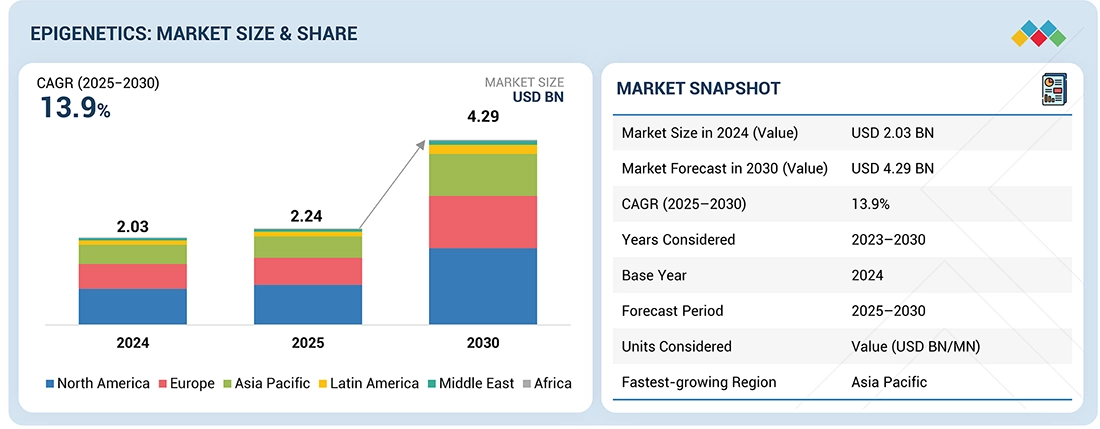
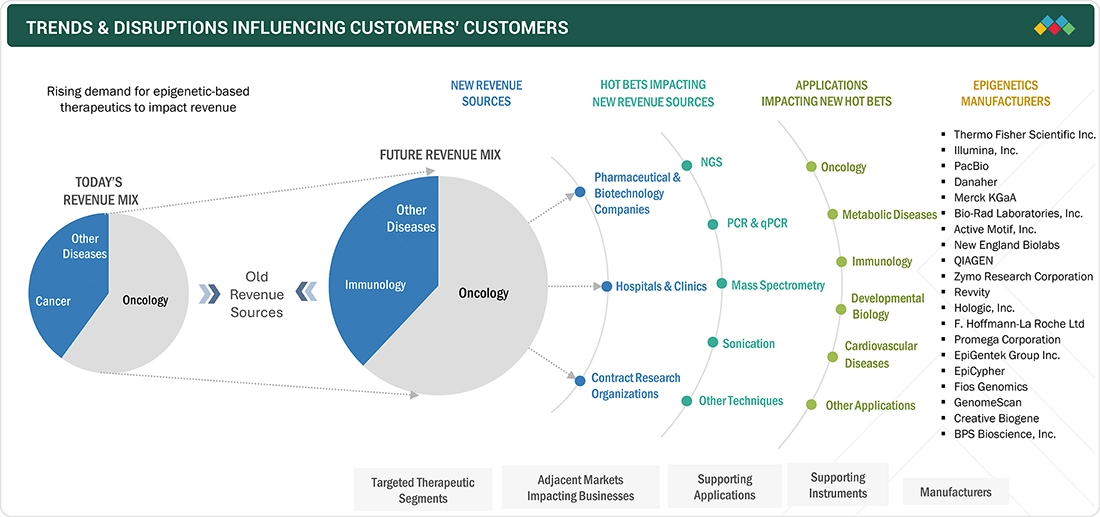



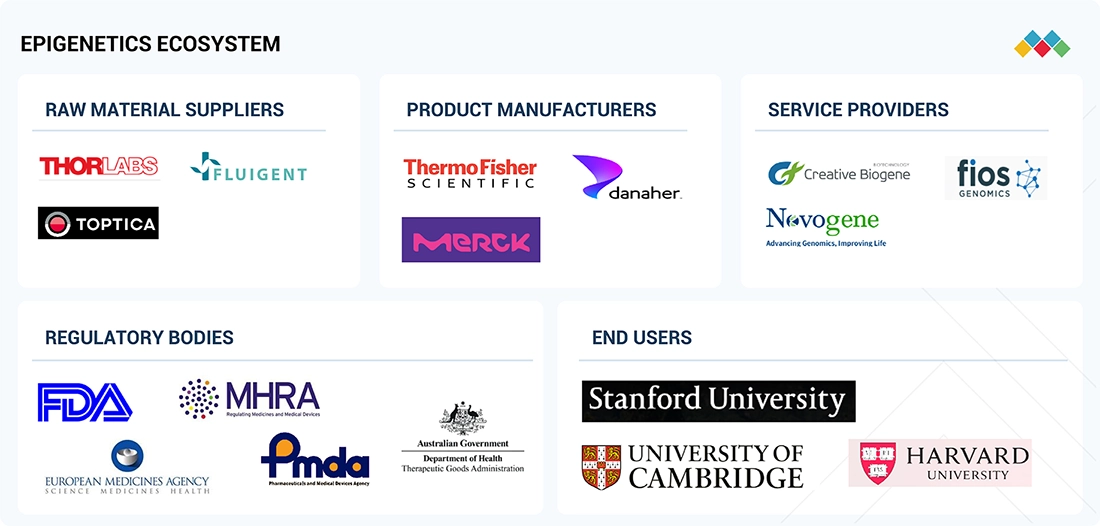
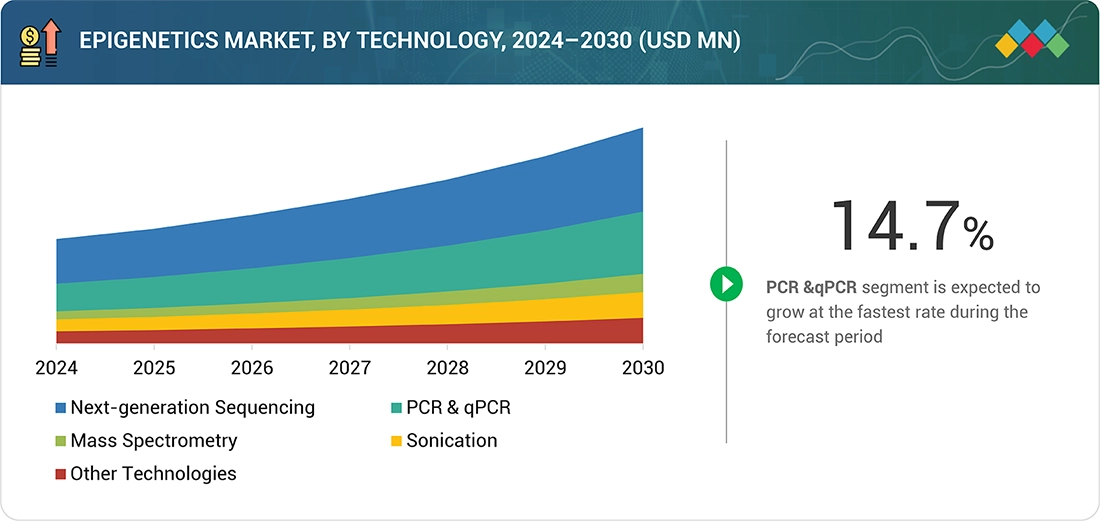
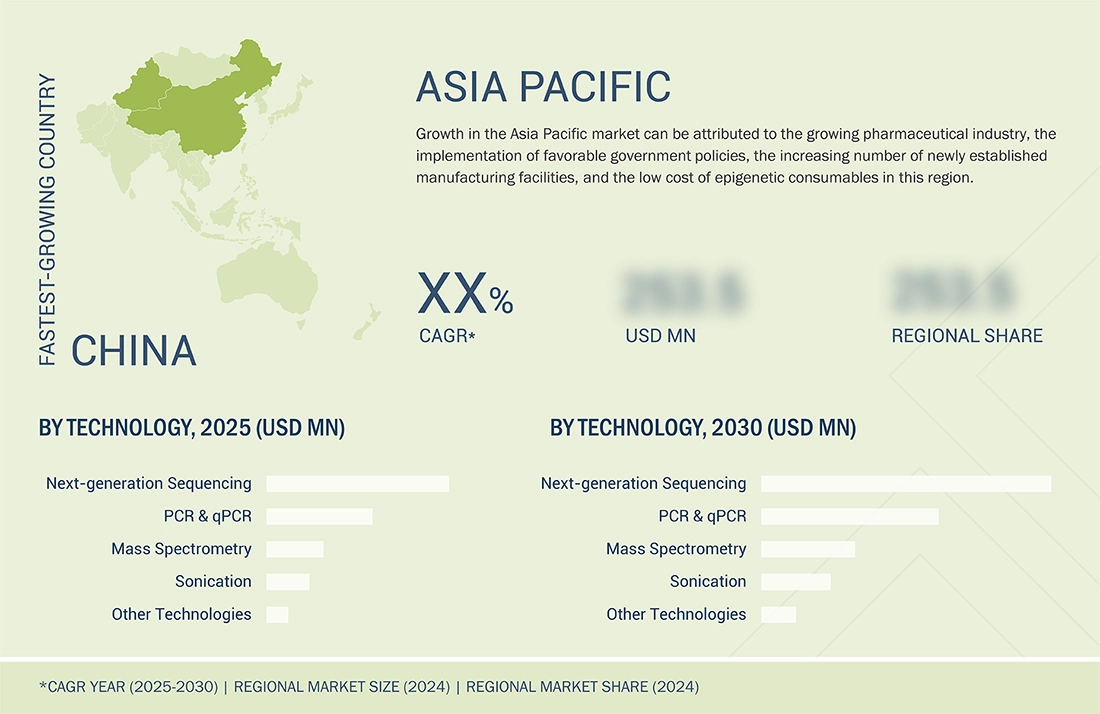
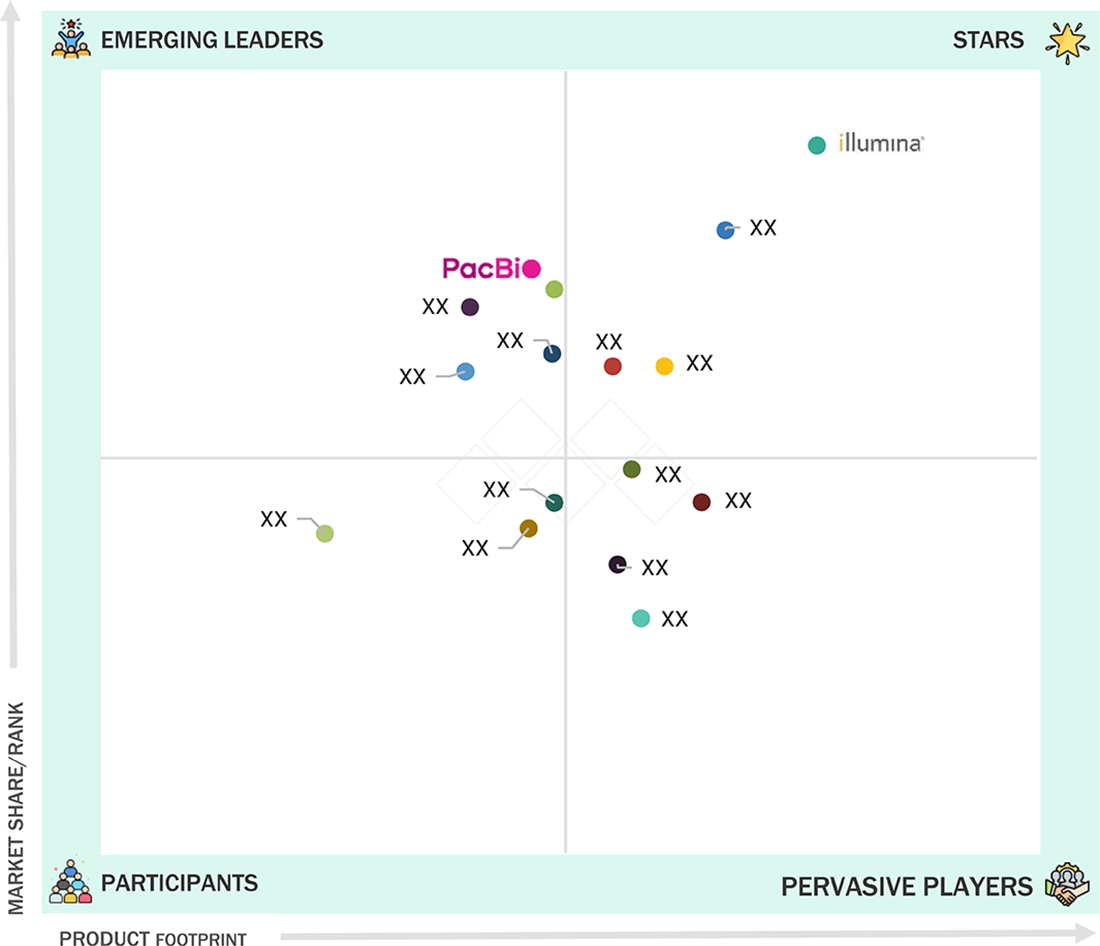
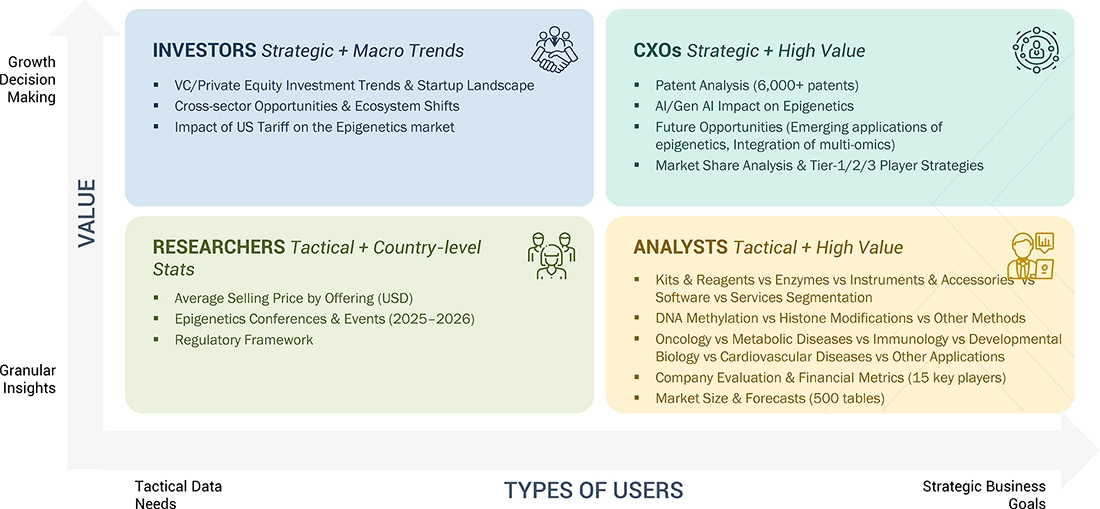

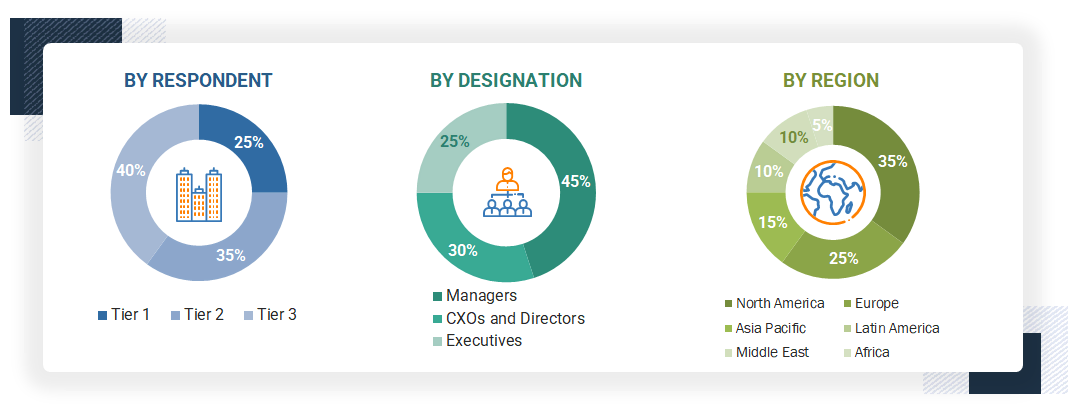
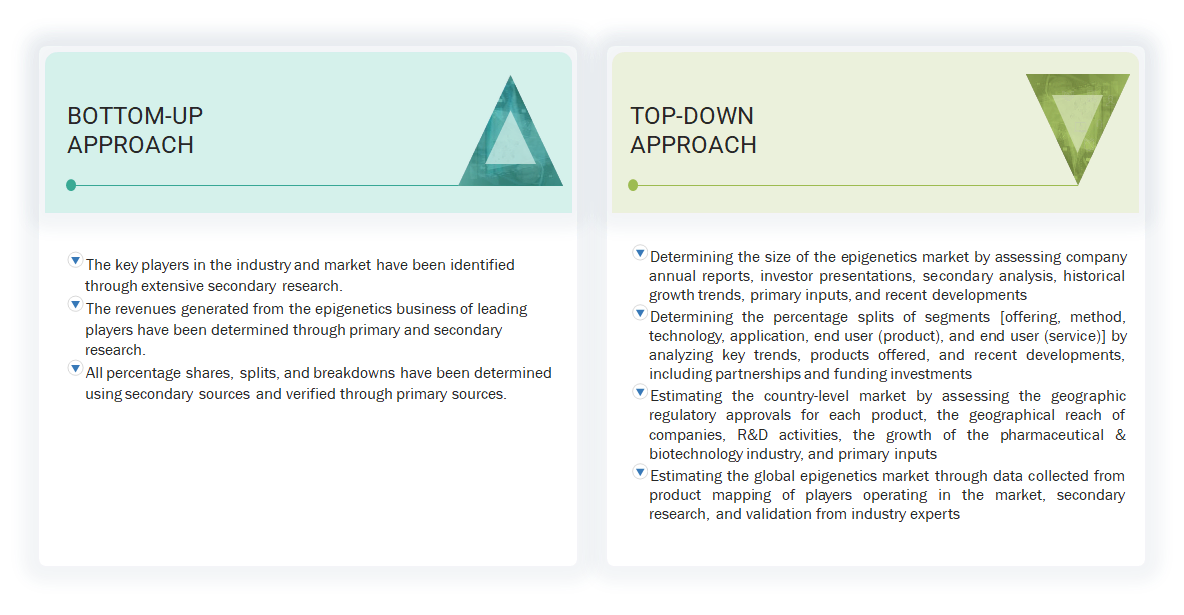













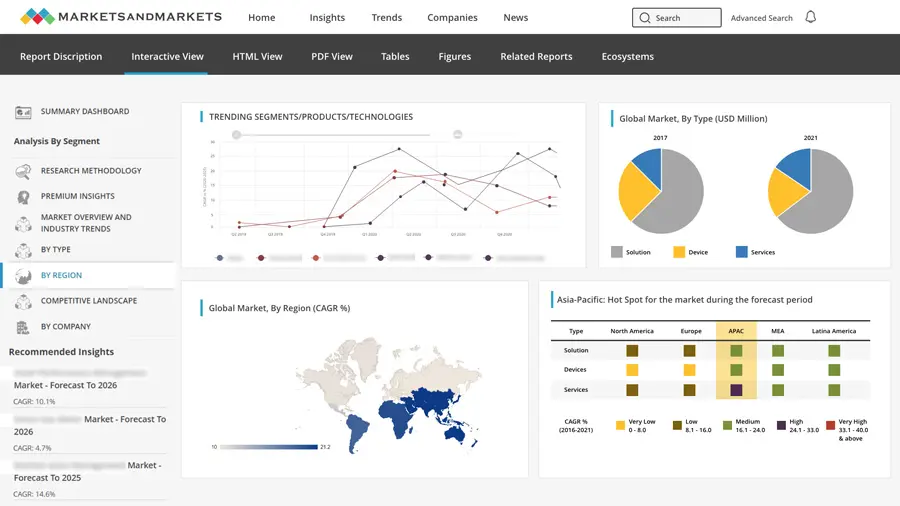
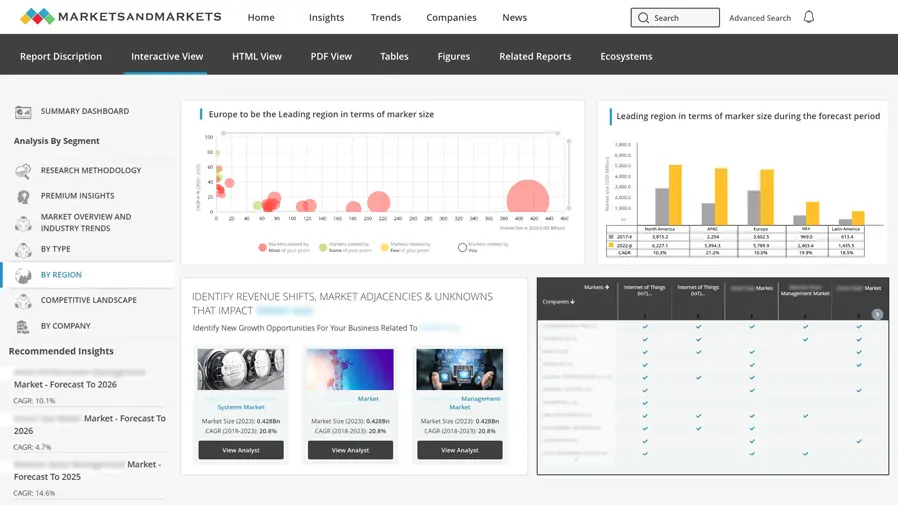
Growth opportunities and latent adjacency in Epigenetics Market